

FarmWise – Intelligent Financial Management for Farms
FarmWise is an advanced system in the FOM (Financial-Operational Model) class, designed for farm owners who want to make all decisions based on data, not assumptions. It is the 190th financial modeling project by Origami Effect, developed in 2024.
This is a solution for the most demanding users. It covers every part of the farm: from fields and herds, through fertilizers, fuel, and leases, to subsidies, cash flow, and asset valuation.
FarmWise is not just a tool for budgeting or financial analysis—it is the decision-making center of your farm, enabling you to manage it like a modern enterprise.
Investment decisions based on hard data
FarmWise enables you to make investment decisions like professional fund managers—using hard data.
Instead of asking “can we afford it?”, you ask: “is it profitable—and by how much?”
The model calculates the profitability of each investment—not just in terms of installments or depreciation. It also analyzes:
- the impact of new equipment on unit costs—for example, how much a ton of grain or a liter of milk costs you now,
- fuel consumption, spare parts, service, and maintenance costs,
- financing scenarios: cash, operating lease, finance lease, loan,
- effects on cash flow, profitability, and cost structure—both across the whole business and specific segments such as feed, milk, crops.
Thanks to this, you can choose the optimal investment timing and show the bank or investor that you have full control over every dollar.
Modernizing your milking parlor? FarmWise shows your real profits
New milking technology is not just about convenience—it’s a decision that impacts every cent earned per liter of milk.
FarmWise precisely calculates investment profitability by analyzing:
- energy use, servicing, and spare parts,
- electricity demand and its impact on monthly costs,
- the effect on cost per liter of milk—before and after the upgrade,
- different financing options and their impact on cash flow.
And if you’re planning photovoltaics—the RES (Renewable Energy Sources) module will show you:
- how much energy you will generate and use in your milking parlor and cold store,
- how much your electricity bills will decrease,
- when the investment will pay off,
- how the cost structure of your dairy operation will change.
This isn’t intuition. This is controlling and investment decision-making at the private equity level.
Analyze any scenario in minutes
Change in feed prices? New source of financing? A different cropping plan?
FarmWise lets you recalculate any scenario instantly—no manual data entry, no risk of errors.
This way, the analyst can focus on insights, not spreadsheet copy-pasting.
Statistical modules—herd health & loss forecasts
FarmWise monitors herd condition.
If disease cases exceed reference values, the system instantly signals a problem—before efficiency drops.
You can also compare strategies:
- treatment vs. vaccination,
- cost of lost milk vs. cost of prevention,
- and choose the option that minimizes losses and optimizes cost per liter of milk.
Crops, subsidies, and machinery—one plan
FarmWise helps you plan crops not just by rotation or sowing structure, but above all: profitability.
The model takes into account:
- availability and efficiency of machinery,
- subsidy structure and crop type,
- impact of decisions on TPC (Total Production Cost), EBIT, and cash flow.
Instead of relying on intuition—you have precise numbers.
Controlling at an unmatched level in the industry
FarmWise is a tool that:
- predicts results before issues arise,
- controls budget and operating costs with engineer-level precision,
- tests “what-if” scenarios based on real data,
- assesses the farm’s value reliably—ready for talks with investors or banks.
The foundation of strategy and operational control for your farm
In over 3 million cells and 300 sheets, logic works to support:
- cost and margin controlling divided by departments, crops, and livestock,
- investment profitability analysis—with a dynamic CAPEX/OPEX model and depreciation,
- liquidity planning—accounting for subsidies, credits, leases, and sales,
- forecasting debt and financing structure over time,
- management and operational reporting—ready for investor or bank meetings,
- full asset valuation—both book and market (adjusted book value),
- assessment of resource utilization efficiency—land, people, machinery, and buildings,
- crop and forage production planning based on the herd’s real needs,
- inventory control—feed, fertilizers, straw, and crop protection products,
- scenario analysis: changes in grain prices, fertilizer costs, subsidies, or digestate availability,
- data integration with OMS and SmartField systems—no need to log in elsewhere.
Straw, fuel, working hours—everything under control
FarmWise doesn’t estimate. It calculates.
Straw:
- predicts bedding and feed needs based on herd size,
- calculates output from each field and yield,
- compares needs with production—you know whether to buy, sell, or expand your acreage.
Fuel and machinery:
- the system knows the consumption norms for fuel, working hours, and labor costs,
- compares planned vs. actual data—instantly detecting deviations (e.g., overly long plowing or excessive fuel use),
- this is real-time operational controlling.
A financial model like no other
FarmWise is likely the largest and most precise farm financial model.
It’s the result of over a dozen years of experience—in controlling, BI, finance, management, and… life on the farm.
It combines precision, flexibility, and speed.
Thanks to it, owners and analysts can make better decisions—faster.
Global Data module in Agro section
collects key data on crops, yields, fuel and fertilizer requirements, and external agricultural services. It provides the foundation for financial and operational analysis for individual crops as well as the entire farm, enabling cost optimization and forecasting of future results based on real data.
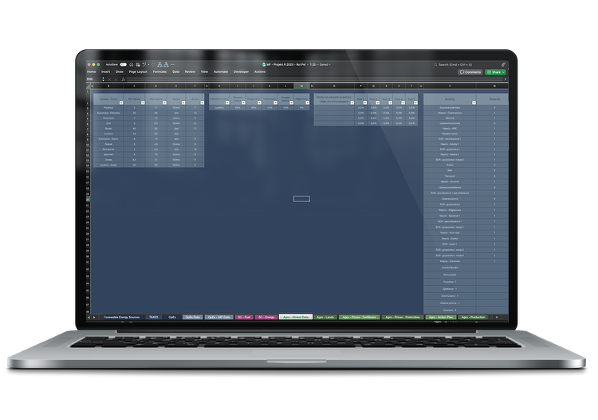
Detailed yield information for various crops, including:
- Minimum and maximum achievable yields
- Crop type (winter/spring)
- Seasonal harvest data
Example: Wheat – min. yield 5 t/ha, max. yield 11 t/ha, type: winter, harvest season: July.
Losses due to improper storage:
- Estimate of losses on feed and other materials resulting from improper storage, which impacts actual production costs.
- Example: Losses in years 1 to 5 amount to 5% for triticale, 0% for corn silage.
Costs of external services for straw production:
- Data on external services related to straw production, fuel requirements for transport, harvesting, and other operations.
- Example: Cost of straw harvesting service per bale, fuel demand per hectare.
Straw production and its demand in crops:
- Data on straw production and its requirements, including conversion rates from straw to yields.
- Information about the price, length, and netting required for bale wrapping, enabling cost planning for straw packaging.
- Examples: Yield-to-straw ratio for wheat – 0.35, for corn silage – 0.35. Netting price for wheat wrapping: 335 PLN in year 1, requirement: 16.6 m.
Agro: Initial Data
The Initial Data module in the Agro section is another component enabling you to tailor the model to the individual conditions of your farm.
This module provides the foundation for building a comprehensive farm financial model and for adapting crop and livestock production strategies to actual resources and operational conditions.
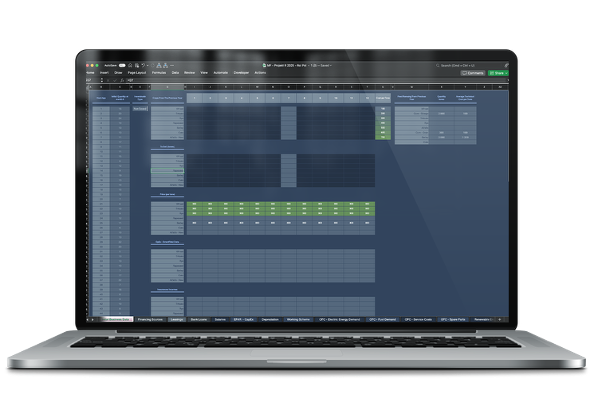
Agro: Initial Data—Sample data areas:
- Herd age: Data on the age structure of animals, enabling precise estimates of feed needs, milk production, and other breeding parameters.
- Initial quantities: Information about the number of each animal group at the start of the month, forming the basis for further production analyses.
- Type of insemination: Choice between sexual or asexual insemination, which affects the herd structure in the long term.
-
Harvests from the previous year: Data on yields from individual crops, including details about available tons of grain and other plants retained from the previous season.
-
Costs and prices: Determining technical costs and prices for individual crops, allowing ongoing profitability calculations.
-
Remaining feed and straw resources: Information about remaining feed and straw resources, including tonnage, technical cost per ton, as well as weight and parameters related to bale packaging.
Agro: Initial Data—Module functionalities:
Preparation of initial state:
- Entering data on herd age and quantity, structure of feed, straw, and crops at the start of analysis.
- Enables precise adaptation of the model to the specifics of the farm.
Stock analysis:
- Monitoring leftovers from the previous year, including exact information on quantities and costs.
Expense management:
- Setting unit costs and prices which serve as the basis for further financial calculations.
Investment scenarios:
- Data entered in this module can serve as a foundation for optimization scenarios, e.g., management of feed and straw resources.
Optimization of crop and livestock planning:
- Facilitates efficiency analysis and determination of potential costs depending on different crop and breeding strategies.
Agro: Land Costs
Agro-Land Costs is a module that monitors costs related to the use of agricultural land. It enables you to assign specific plots to lease agreements or agricultural loans (bank loans or leases).
Thanks to this, you can accurately track expenditures associated with individual fields and easily forecast land use costs for the future.
This module is especially useful for analyzing the cost structure of the farm and optimizing expenditures based on the profitability of different crops on each plot.
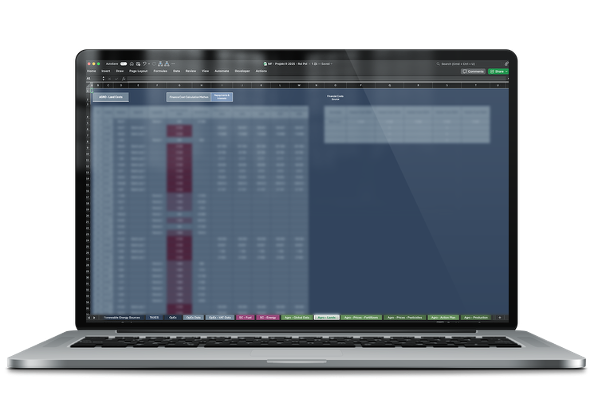
The module is designed for a flexible approach to managing various financing forms. Each plot can be associated with a specific financing method, e.g., a bank loan or a lease. This allows full overview of costs to be incurred over the coming years related to land usage.
By using this module, the user gains the ability to review both total and unit costs for each plot, including rent and financing expenses. This module gives the farming enterprise a tool for making more informed financial decisions related to land, taking into account current costs as well as forecasts for the coming years.
Agro: Prices – Fertilizers
The Agro – Prices Fertilizer module is a tool designed for comprehensive management of fertilizer and seed material costs on a farm. Thanks to a detailed cost table broken down by quarters and years, the user can monitor, analyze, and optimize expenses related to fertilization and sowing for each field.
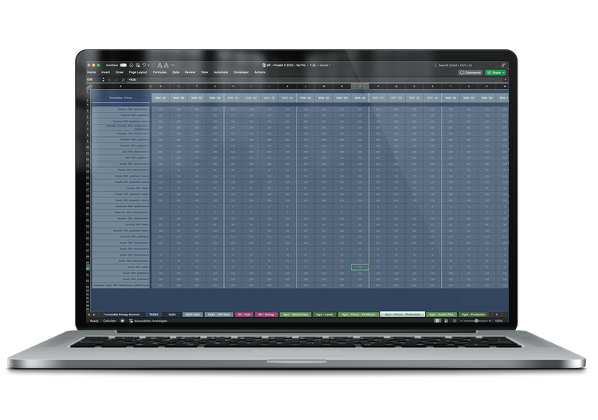
The module features a dynamic cost-setting function based on various fertilizer types such as NPK, ammonium nitrate, urea, and others, as well as seed materials for specific crops. The user can view the per-hectare costs for each fertilizer and seed, allowing for precise budget planning in relation to actual crop needs.
Thanks to this module, an agricultural enterprise can easily forecast fertilization-related expenses several years ahead, taking into account changing prices and requirements for individual fertilizers. This module is a key element in optimizing crop production costs and enables a rapid response to market price changes for fertilizers.
Agro: Prices – Pesticides
The “Agro – Pesticides Prices” module is used to monitor and analyze the costs of plant protection products (PPP) for various crops, such as wheat, corn, rapeseed, barley, beets, and others. The data covers quarterly prices over several years, making it possible to track and forecast expenses related to protecting crops from weeds, fungi, and pests in detail.
This module is flexible and allows you to adjust plant protection strategies in response to price changes and the specific needs of each crop.
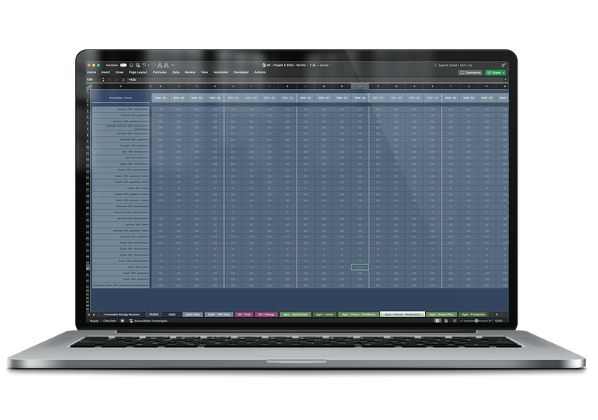
AGRO: PRICES – PESTICIDES – FUNCTIONALITIES
Quarterly pesticide cost tracking: The module enables analysis of plant protection product costs for various crops, allowing you to control expenditures in each quarter.
Overview of prices for different protection types:
- Broadleaf (e.g., herbicides against broadleaf weeds).
- Fungicide (fungicides targeting fungal diseases).
- Insect (insecticides or protective mixes for pests).
Budget forecasting:
The module contains data for subsequent years, making it easier to create a crop protection budget and plan expenditures.
Flexibility in scenario analysis:
In combination with other model modules, you can conduct scenario analyses, e.g., in case of rising protection product prices on the market or changes in the crop protection strategy.
Agro: Action Plan
Moduł „Agro – Action Plan wspomaga szczegółowe planowanie i zarządzanie procesami upraw w gospodarstwie rolnym.
Dzięki niemu użytkownik może precyzyjnie określić harmonogram i zapotrzebowanie na materiały oraz usługi zewnętrzne dla różnych upraw, takich jak pszenica, kukurydza, pszenżyto, żyto, rzepak, słonecznik, jęczmień, lucerna i buraki.
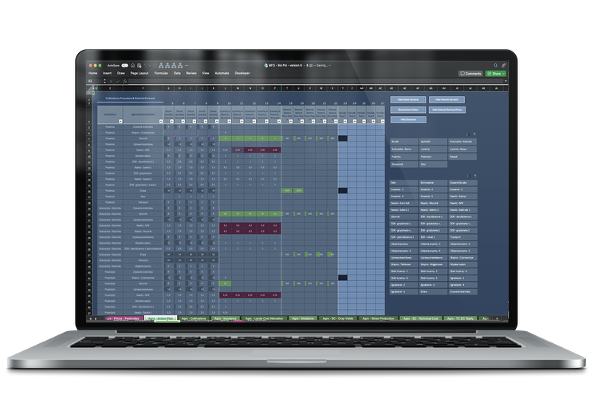
The “Agro – Action Plan Cultivations Procedure & Material Demand” module is a key tool supporting integrated planning and monitoring of crop processes, which translates to more efficient farm production management.
It ensures full transparency in resource planning for each crop.
Production cost optimization is made possible by precisely determining material and service requirements.
Seasonal demand for fuel and materials can be analyzed using this tool.
It supports sustainable resource management through detailed analysis of how agricultural activities affect production costs and farm profits.
Analyzing the Impact of New Technologies and Machinery
The user can simulate introducing new machines with various parameters, such as fuel consumption or efficiency, which allows for assessing how these changes affect operational costs and production efficiency.
For example, the module makes it possible to estimate how more efficient machines may reduce fuel consumption, directly impacting production costs.
Defining Specific Tasks and Material Consumption
The module lets the user specify crop-related tasks—such as fertilization, plowing, sowing, and more—and the amounts of materials needed for each.
This enables precise cost planning and controlling material demand, supporting optimal resource utilization.
Substitution of Synthetic Fertilizers with Digestate
The module allows for modeling the impact of replacing synthetic fertilizers with digestate from biogas plants. With this feature, the user can analyze how reducing synthetic fertilizer use in favor of digestate affects costs and crop efficiency.
Such substitution may be financially advantageous and support sustainable development strategies by reducing costs and potentially improving soil quality.
AGRO: ACTION PLAN – FUNCTIONS
Planning agrotechnical activities:
The module allows you to define actions such as stubble breaking, liming, fertilization, sowing, applying plant protection products, and harvesting for each crop.
Determining fuel and material requirements:
Each activity is assigned fuel and material usage (fertilizers, seeds, plant protection products) for different seasons, enabling strict monitoring and analysis of resource needs and costs.
Costs of external services:
The module makes it possible to include costs for external services such as harrowing or silage compaction, allowing for more accurate expense prediction and budget planning.
Dynamic multi-year cost management:
Each cost and material parameter can be set for a five-year period, enabling forecasting and optimization of expenditures.
Monitoring impact on costs and profitability:
The module allows analysis of how different cultivation strategies affect overall production costs and profitability, considering variables such as fuel and material amounts, costs of external services, and raw material prices.
Seasonal planning optimization:
Planning fuel and material requirements for individual actions in specific seasons ensures precise adaptation of the production process to seasonality and resource availability.
Flexible management of various crops:
With the ability to customize activities and material requirements for different crops, the module is versatile and flexible, allowing full adjustment to the specifics and scale of any farm.
Agro: Land Costs Allocation
The Agro – Land Cost Allocation module is designed to enable precise assignment of financial and rental costs to individual crops, allowing for accurate control and analysis of land use costs over multiple seasons.
This functionality is particularly useful for farms managing various forms of financing, such as bank loans or leases, and renting land on different terms. With this module, the user can analyze how land use costs affect the profitability of individual crops, as well as better understand the impact of expenditures on the overall farm budget.
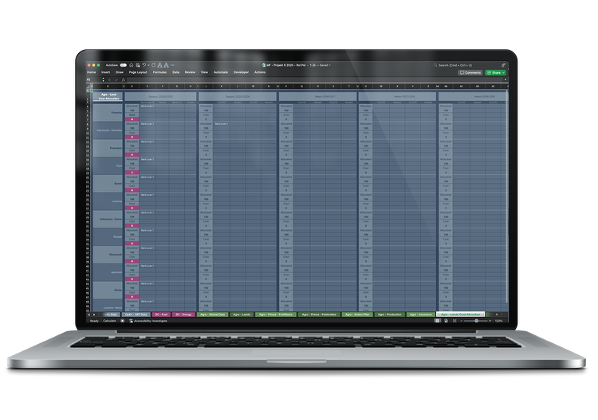
AGRO: LAND COSTS ALLOCATION – OBJECTIVES
Precise Cost Control.
The module enables accurate assignment of land usage costs to specific crops, supporting better financial control and allowing identification of costs affecting profitability.
Financing Optimization.
By analyzing the allocation of costs to specific hectares, the user can make more informed decisions regarding land financing, which can lead to savings.
Long-Term Planning
The module provides cost forecasts over five years, enabling better planning and strategic decision-making in the context of land resource allocation.
Easy Visualization of Expenses.
With precise assignment of financial and rental costs to crops, the user can more easily identify the impact of specific expenses on the overall profitability of the farm, supporting strategic decision-making.
AGRO: LAND COSTS ALLOCATION – FUNCTIONALITIES
Assignment of Financial Costs.
The user can allocate costs resulting from bank loans to specific hectares dedicated to certain crops, enabling more precise land financing management.
Assignment of Rental Costs.
The module allows rental costs to be assigned to individual crops, allowing better monitoring and control of expenses related to land leasing.
Multi-year Cost Forecast.
The user can monitor changes in costs over several years, analyzing the impact of financial and rental expenses on farm profitability over five years.
Integration with the Financing System.
The module integrates with other elements of the financial model, such as the Finance Core module, enabling a more comprehensive analysis of total costs and profitability.
Flexibility in Resource Allocation.
The user can flexibly allocate land to different financing and leasing arrangements, supporting decisions related to optimization of operating costs.
Agro: Dotations
The Agro – Cultivation Planning module is the essence of effective production management in the FOM, combining detailed control with simplicity of use.
It allows the user to precisely manage the cultivation area by assigning specific hectares to particular crops while simultaneously forecasting their yields and profitability.
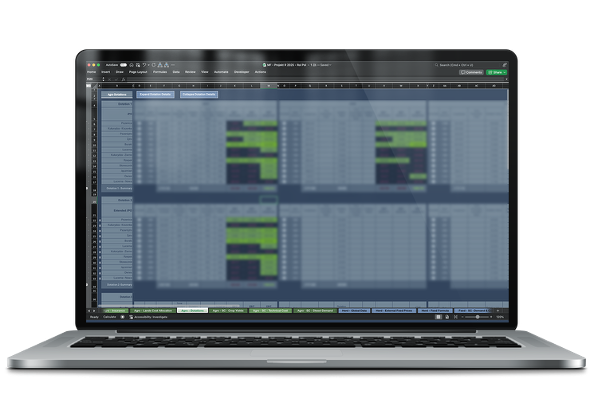
Assigning Subsidies to Crops.
The user can indicate which crops qualify for various subsidies and enter subsidy amounts for each year. This allows modeling of different financial support scenarios.
Production Cost Analysis.
The module calculates production costs before and after accounting for subsidies, providing a complete view of how financial support affects unit costs and overall financial performance.
EBIT Simulation (Operating Profit).
The user can run EBIT simulations for different scenarios, analyzing outcomes with and without subsidies. The module also allows calculating EBIT in situations where only part of available subsidies is received, making planning more realistic.
Calculating Margin per Ton of Production.
By factoring in subsidies, the user can calculate the margin per ton for each crop. This makes it easier to understand which crops are the most profitable with a given level of financial support.
Agro: Dotations – Example of Use.
A user growing wheat can enter data about subsidies and investments needed to achieve specific production goals. The module will calculate production costs per ton, taking the subsidy support into account, and indicate at what point production exceeds the break-even threshold. Based on this, the user can decide to expand or reduce a given crop, optimizing economic and financial strategy.
The Agro – Dotations module is an advanced planning and financial analysis tool, supporting farmers in strategic crop management with the assistance of external funding.
Agro: Insurances
The module is designed to manage crop insurance, allowing the user to strictly control insurance costs and forecast potential payouts due to crop damage.
This module accounts for the specifics of each crop, such as insurance premium amount, yield protection level, and seasonal months of premium payments and disbursements.
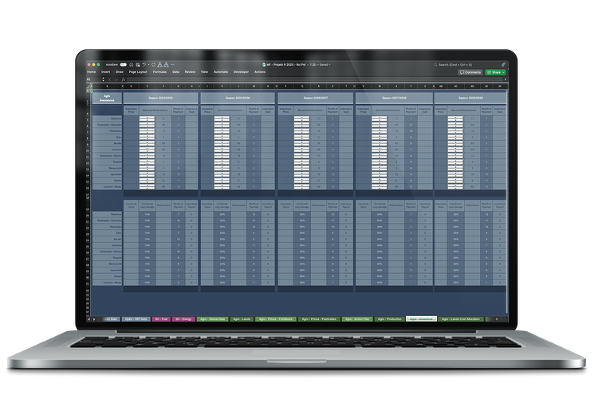
AGRO: INSURANCES – FUNCTIONALITIES
Defining Insurance Costs
The user can set insurance premiums for each crop and specify the month of payment. This allows monitoring of annual insurance costs and better management of financial flows related to insurance expenditures.
Yield Protection.
The module automatically calculates potential insurance payouts based on the set yield protection level. The user can enter a protection threshold, e.g., four tons, meaning if actual yields fall below this value, the model will automatically calculate the amount of a potential insurance payout. This allows the user to easily monitor crop protection and anticipate the impact of possible yield losses on farm finances.
Agro: Cultivations & Market Operations
The Agro – Cultivation Planning module is the essence of effective agricultural production management in the FOM, combining detailed control with simplicity of use.
It allows the user to precisely manage the cultivation area, assigning specific hectares to particular crops while simultaneously forecasting their yields and profitability.
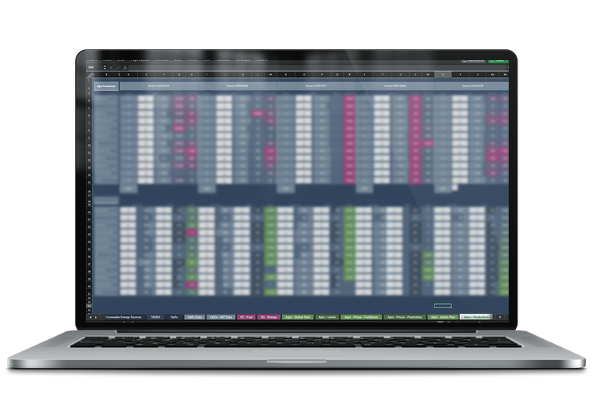
AGRO: CULTIVATIONS & MARKET OPERATIONS – FUNCTIONALITIES
Dynamic profitability calculation:
Thanks to the ability to enter current market prices for each crop, the user instantly receives information on production costs per ton and the actual profit margin achievable. This enables real-time decision-making, responding to changes in prices or production costs.
Integrated cost analysis:
The module automatically includes all direct and indirect production costs, allowing precise calculation of the total production cost for each ton. This tool provides a complete picture of profitability, with the resulting margin taking all financial aspects into account.
Precise cultivation area analysis:
The ability to assign hectares to selected crops, with an additional option to define the percentage realization of the planned yield. The user can then see what resources are engaged and what results can be achieved.
Sales forecasts:
The module enables specification of the percentage of harvest intended for sale, which allows quick calculation of the amount of product that will go to market and what will be used internally. Any surpluses are automatically allocated to the feed warehouse or inventory, supporting stock control.
Intelligent inventory management:
The portion of the harvest not intended for sale automatically goes to the feed warehouse and inventory (enterprise balance sheet), allowing optimized internal resource management without manual calculations.
The module is not only an analytical tool but also a practical guide to effective farm production management. Thanks to integration with other AGRO section modules, the user gains full control over the cultivation process—from planning to sales, with the ability to thoroughly analyze each step and react instantly to changing market conditions.
AGRO: STRAW PRODUCTION
The Straw Production module is a versatile tool dedicated to managing straw production, which not only enables planning and monitoring of the entire production process but also dynamically adapts to the farm’s needs.
Thanks to full integration with other modules in the AGRO and Herd sections, the Straw Production module provides comprehensive information about straw demand, including its use as bedding for cows and as a feed component.
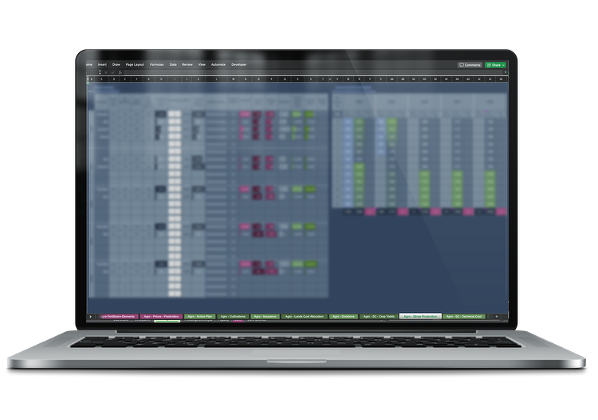
AGRO: STRAW PRODUCTION – FUNCTIONALITIES
Precise Straw Production Planning:
The user can allocate hectares to individual crops (such as triticale, rye, barley, etc.), and the module automatically calculates the straw-to-grain ratio and the total attainable straw weight. Based on this, the maximum number of bales that can be produced and the percentage of straw intended for production are determined.
Dynamic Straw Demand Management:
The module provides continuous insight into dynamic straw demand, accounting for both current inventory levels and the needs of the farm for bedding and cow feed. These needs are automatically calculated by other modules in the Herd section, enabling the user to fully understand and control the amount of straw required for daily farm operations.
Tracking Production and Logistics Costs:
The module allows detailed specification of straw production and transport costs, including parameters like transport distance and production source (e.g., in-house production or external service). Based on this data, the module automatically calculates unit costs, such as cost per bale and cost per ton, enabling precise monitoring and optimization of expenditures.
Profitability and Margin Analysis:
The module allows the user to quickly check whether straw production is profitable via dynamic calculation of market value based on average prices and margin computation. The user can monitor production profitability in real time, considering both direct and indirect costs and available subsidies.
Forecasts and Future Planning:
The Straw Production module lets the user forecast straw production for upcoming seasons (2024–2028), considering changing parameters such as crop yields, investment costs, and market prices. This enables precise planning for future straw needs and advance adjustment of production strategies to maximize farm profitability.
Automatic Data Update and Synchronization:
The module is fully integrated with other modules in the AGRO and Herd sections, so straw demand data is updated automatically. If parameters like market price, inventory level, or yield size change, the module automatically recalculates values, always providing the user with up-to-date and accurate information.
Agro: Crops technical costs
The module offers advanced analysis of technical costs for individual crops, taking into account both direct and indirect production costs at each stage. This module integrates data from other sections of the AGRO suite, enabling the user to conduct an in-depth assessment of cost efficiency and the market potential of each crop.
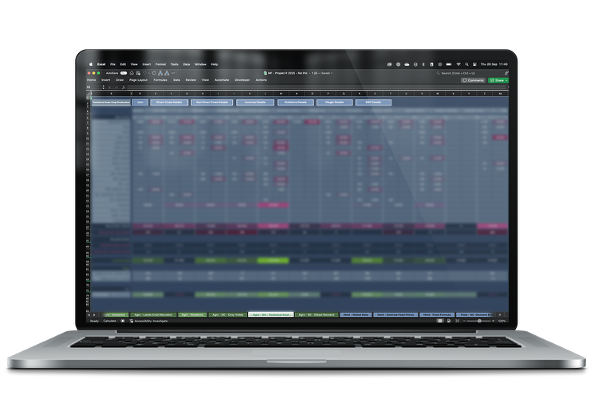
The Technical Cost module enables precise management of crop costs and revenues, as well as optimization of cost structure based on actual and forecast data. Thanks to integration with other AGRO modules, the user can dynamically adjust production plans in response to changes in market prices, available subsidies, or resource costs such as fuel.
This module is an essential tool for profitability planning and analysis, supporting users in making effective strategic decisions.
Direct and Indirect Cost Calculation:
Each crop receives a detailed report on direct costs, such as diesel fuel, fertilizers, and plant protection products, as well as indirect costs, such as land financing costs or rent. This detailed data enables precise tracking of expenditures and budget optimization.
Cost per Ton of Production:
The module automatically calculates the production cost per ton based on direct and indirect costs. This allows the user to quickly see the real production costs for each crop, which is crucial for profitability analysis.
Margin and Market Price Analysis:
Based on the entered market prices, the module calculates the margin per ton and total revenue from each crop, taking into account the quantities allocated for sale. The module dynamically indicates which crops are most profitable, enabling strategic production planning.
Subsidy Integration and Impact on EBIT:
The module offers financial results simulation at various subsidy levels. Depending on the available subsidies (from 1 to 6), the module recalculates EBIT including financial support, showing its impact on the profitability of each crop. This lets the user see how various subsidies affect the final financial result.
By-products:
The module takes into account by-products, such as straw or sugar beet pulp, along with their production costs and market values. This feature allows more complete utilization of by-products, which can supply the warehouse or generate additional income.
HERD: GLOBAL DATA
The Herd – Global Data module provides the foundation for managing data related to the entire life cycle of dairy cows, enabling precise modeling of costs and benefits at every stage of development and production.
Each stage in the animal’s life—from calf, through heifer, to dairy cow—is described with key parameters such as age, weight, weight gain, lactation cycle, manure production, and straw consumption.
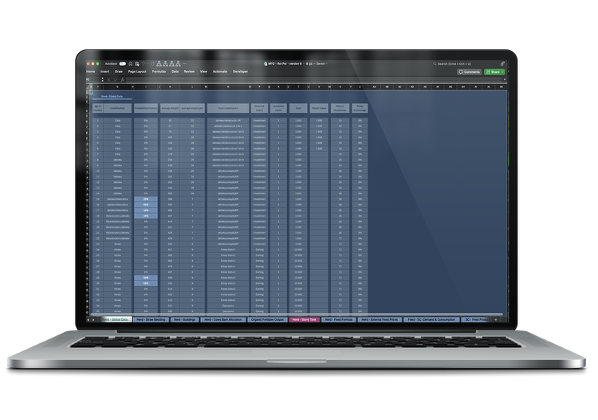
Thanks to precise data on the costs and market value of animals in individual age groups, the module allows for profitability analysis and assessment of return on investment according to financial classification (e.g., “Investment” for heifers and “Earning” for dairy cows).
Information about the lactation cycle enables better management of milk production, including forecasting the impact of specific phases on costs and revenues.
The module also accounts for parameters such as the probability of estrus and manure production, which supports waste management and optimization of straw (bedding) requirements—with automatic stock tracking included.
By integrating with other Herd section modules and the rest of the model, Herd – Global Data becomes a comprehensive tool for financial and operational analysis of the livestock farm, providing insight into current costs and the ability to model future herd development scenarios.
HERD: STRAW BEDDING
The Straw Bedding module serves for precise management of bedding requirements for different cattle groups on the farm.
It is an advanced tool that enables tracking and planning of straw consumption throughout the entire year, adapting to seasonal changes in the needs of each animal group.
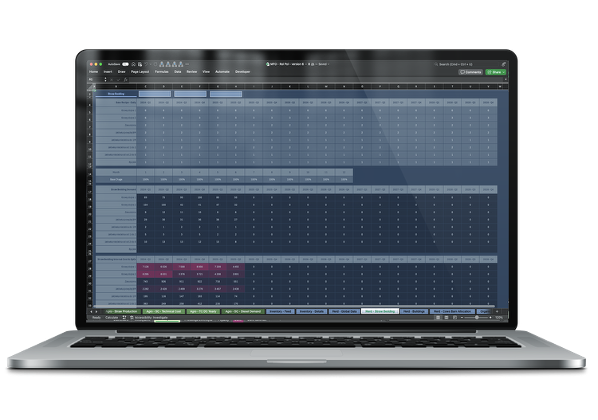
HERD: STRAW BEDDING – FUNCTIONALITIES
Daily Bedding Recipe:
The module allows you to set the basic daily straw requirement for each animal class, such as “Milking cows,” “Heifers,” or “Dry cows.” This enables precise planning of straw consumption for each group based on their numbers and specific needs.
Quarterly Consumption Forecast:
The module shows quarterly straw demand, taking into account changes in herd size and status. This enables dynamic adjustment of the bedding consumption plan and securing sufficient straw stock in storage.
Internal and Operating Costs:
The module calculates straw usage costs per animal group for each quarter, providing a complete picture of operational bedding costs. These costs are calculated based on straw price data, dynamically computed own-production straw costs, and the amount used by each animal group.
Integration with Herd Management Modules:
The Straw Bedding module is closely integrated with other Herd section modules, allowing automatic updates of straw requirements based on cattle numbers and age classes. Any changes in the herd (e.g., increase in the number of milking cows) are automatically reflected in forecast straw demand.
Warehouse Resource Monitoring:
The module enables dynamic tracking of straw inventory used for bedding and feed. This allows real-time control of stock levels and adjustment of requirements to meet the current needs of the herd.
HERD – Buildings & Straw Beddings
The Herd – Buildings & Straw Beddings module is a versatile tool for managing livestock housing and bedding needs in individual farm buildings.
With advanced functions and flexible settings, the module provides a complete range of information needed to optimize herd management and straw resources.
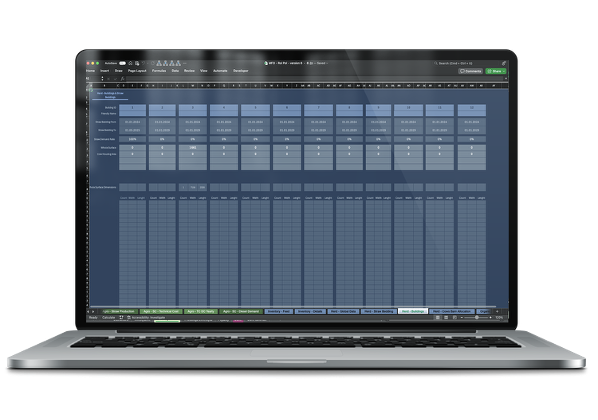
HERD – BUILDINGS & STRAW BEDDINGS – FUNCTIONALITIES
Straw Bedding Period Management:
Enables precise setting of start and end dates for straw bedding in a given building. This feature allows bedding schedules to be adapted to the herd’s seasonal needs and straw availability, helping improve resource management.
Dynamic Calculation of Bedding Requirements:
The module allows assignment of a percentage indicator of straw demand for each building, enabling dynamic adjustment of bedding consumption according to current needs. For example, if Building 1 requires full demand (100%), and other buildings do not need bedding (0%), the module automatically recalculates total straw requirements.
Building Area Management:
The module allows detailed management of housing space, considering total building area and dedicated cow zones. By entering dimensions, such as width and length for each building, the user can precisely determine available space, supporting efficient animal placement planning.
Automatic Calculation of Cow Density:
One key feature is automatic calculation of cow density in a given space. By entering building dimensions and animal numbers, the user can quickly obtain information about optimal herd density, supporting decisions on space management and animal comfort.
Integration with Other Modules:
The Buildings & Straw Beddings module is closely integrated with other Herd modules, allowing continuous data updates and adjustment to changing herd needs. Entered data are automatically reflected in straw demand forecasts, enabling dynamic resource allocation for current herd requirements.
Resource Planning by Area:
Detailed management of livestock building dimensions allows the user to precisely plan bedding needs for each space. This allows bedding levels to be matched to the building’s function—for example, facilities for milking cows may require different straw amounts than those for heifers.
Herd: Cow Barn Allocation
The Herd – Cow Barn Allocation module is a tool that supports managing herd placement within livestock buildings according to quarterly needs.
With this functionality, users can precisely allocate different groups of animals to appropriate spaces, enabling optimal use of infrastructure and ensuring comfortable housing conditions.
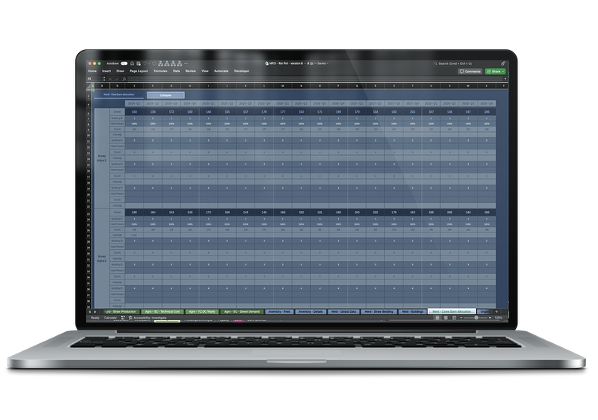
HERD: COW BARN ALLOCATION – FUNCTIONALITIES
Precise Group Allocation:
The module allows for assigning animal groups, such as milking cows, heifers, and dry cows, to the relevant buildings each quarter. Each group is assigned to a specific building (building ID), and the module displays detailed information about the number of animals assigned to each building, providing full control over herd distribution.
Dynamic Herd Population Management:
The module tracks changes in the number of each animal group across quarters, enabling up-to-date allocation adjustments. The numbers in each group are updated automatically, allowing the user to monitor increases and decreases in population and adjust space to evolving needs.
Density Index:
The module calculates the density index for each group of animals in a building, providing complete insight into space utilization. With this function, the user can monitor whether the number of animals in a building is optimal and meets husbandry standards, enabling rapid identification of overcrowding or unused space.
Flexible Building-Level Allocation Management:
Each building can be individually configured regarding animal numbers, allowing dynamic adaptation of spaces to different groups’ needs. The module enables precise animal allocation management, as well as monitoring building occupancy during any period, supporting optimal breeding planning.
Clear Allocation and Density Visualization:
All data is clearly presented, letting the user easily monitor the number of animals assigned to each building in each quarter and track which buildings are currently in use. This clarity enables quick identification of infrastructure adjustment needs or allocation changes in response to changing breeding conditions.
HERD – Feed Formula
The Feed Formula module enables the creation of detailed feed recipes for the herd, with the ability to adjust them according to the period.
The module automatically calculates feed requirements based on the size and age structure of the herd, using data from the agro and feed production modules.
With this feature, the user can precisely plan the feed budget and control expenses by adjusting recipes to changing economic and production conditions.
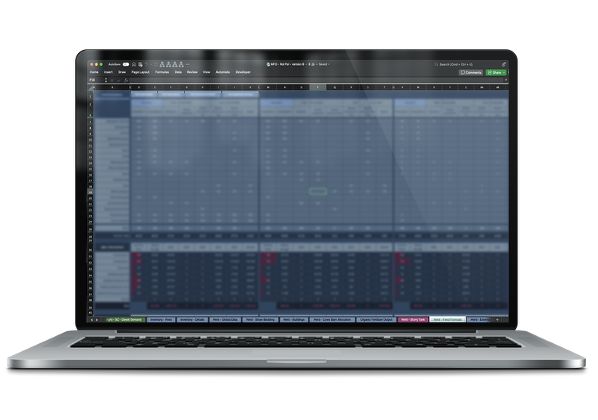
HERD – Feed Formula – FUNCTIONALITIES
Strict Cost Monitoring:
The module allows users to calculate costs associated with delivering feed from both internal resources and external sources. This enables precise control over operational expenses (OpEx) related to purchasing or onsite production of feed ingredients. It facilitates budget planning and optimizes animal nutrition costs.
Diversity of Feed Formulas:
The module allows creation of up to 10 different feed formulas, which users can adapt to the specific needs of each animal group (e.g., milking cows, heifers, dry cows). Each formula can have a defined validity period, making it easier to seasonally adjust animal diets without manually updating all data.
Precise Demand Analysis:
The module calculates nutritional ingredient requirements for various animal groups, enabling accurate determination of the amounts of feed needed daily and monthly. This improves resource and purchasing planning, minimizing the risk of feed shortages or surpluses.
Multi-Year Demand and Cost Calculations:
With the ability to analyze data over several years, the module supports long-term financial planning. It calculates annual feed demand and related costs, enabling analysis of the impact of feeding strategy on the budget in a multi-year perspective.
Dynamic Expense and Average Cost Tracking:
The module generates average monthly feed costs for each animal group and each formula, allowing transparent comparison of expenses on different formulas over time. This enables decisions based on actual nutrition costs, analyzing which formula best supports farm financial efficiency.
Detailed Feed Ingredient Overview:
The module presents a list of particular feed ingredients, such as corn silage, alfalfa, sugar beet pulp, or corn grain. For each formula, different ingredient quantities can be entered, which serve as the basis for demand and cost calculations but are not automatically adjusted.
HERD: INVENTORY TRANSACTIONS
The “Inventory Transactions” module in the financial model is used to manage all transactions related to the herd, enabling tracking of purchase, sale, and herd flow history over the months.
Below is a detailed description of its functions and capabilities:
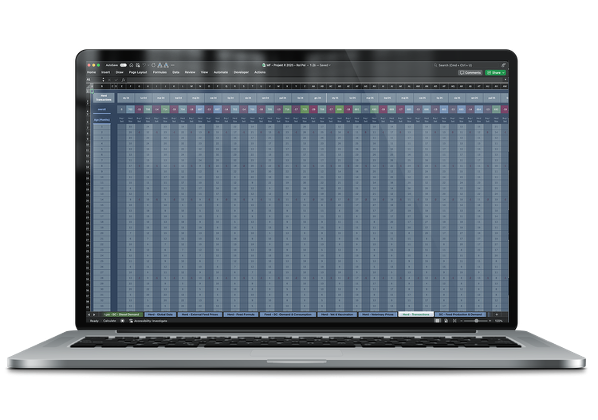
Module functionalities:
Registration of purchases, sales, and transfers
Every movement in the herd can be precisely recorded, with detailed parameters assigned to each transaction.
Production cycle tracking
The system automatically assigns cows to appropriate production stages based on their age and status, eliminating the need for manual cycle management.
Automatic determination of exit moment from the herd
The model identifies situations where animals reach the age or condition requiring departure from the herd, enabling optimal resource planning and accurate production forecasts.
Herd status analysis
Possibility to generate reports about the current herd composition, allowing assessment of age and production structure.
In this module, besides recording basic herd movements, the model independently tracks and calculates changes related to the age and production cycles of dairy cows.
This means that entered data about age and transaction date allows the system to automatically assign animals to appropriate production cycles (such as lactation or dry-off periods), and also identify situations when cows reach the moment of exit from the herd.
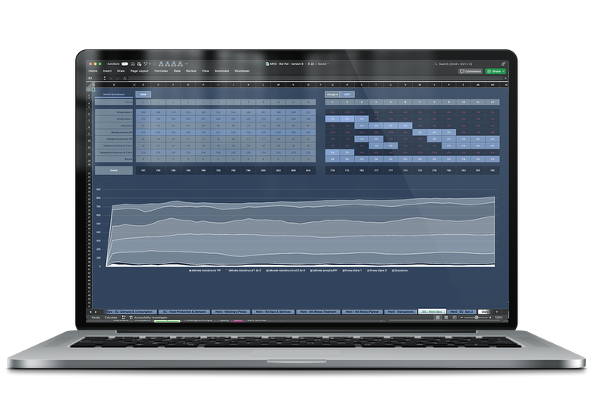
Such functionality enables more accurate planning and analysis of herd efficiency, removing the need for manual tracking of cycles and allowing for more precise forecasting of future production results.
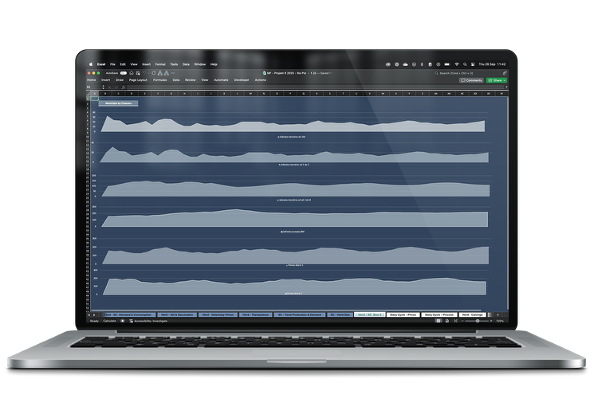
HERD – Feed Demand & Consumption
The “Feed Demand” module is used for comprehensive planning of the herd’s nutritional requirements for upcoming quarters, accounting for both feeds produced on-site and those that need to be purchased.
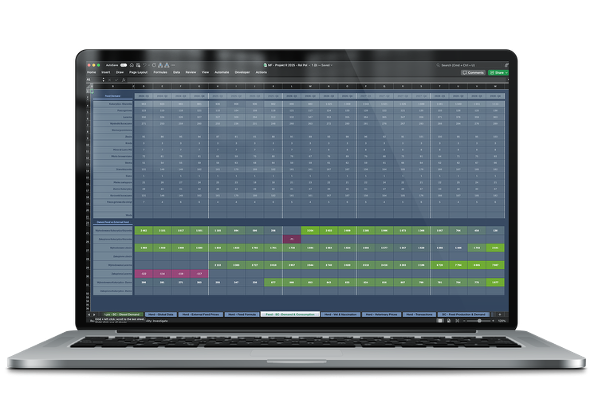
FEED DEMAND & CONSUMPTION – FUNCTIONALITIES
Quarterly demand forecast:
For each feed component, forecast quantities are provided for upcoming quarters from 2024 Q1 to 2028 Q4. This allows for ongoing tracking of requirements and facilitates inventory management and order planning.
Homegrown vs. purchased feed:
The system distinguishes between feeds grown on-site and those purchased from suppliers. For each item, such as corn silage, grain, alfalfa, or corn (grain), information is available about quantities produced and purchased in a given quarter.
Homegrown feed:
Quantities of feed from the farm’s own production, allowing more efficient resource management.
Purchased feed:
Forecasted demand for feeds that need to be purchased from suppliers when there is a shortfall in own production.
Inventory management and cost optimization:
Thanks to the division between own and purchased feed, the module enables users to plan purchases more effectively and minimize costs by optimizing the use of farm-produced feed.
Planning based on feeding cycles:
The module takes into account varying nutritional needs resulting from the herd’s production cycles, such as periods of lactation, dry-off, and other production phases, allowing precise adjustment of feed demand.
Availability forecast:
The module provides forecasts regarding the availability of key feeds, enabling the farm to prepare for periods of potential shortages or surpluses, which is crucial for production stability.
With precise data, the user can accurately monitor and analyze the quantities of required feed components and their availability in storage and from external suppliers. The module provides detailed forecasts, helping to manage inventory and plan feed expenditures.
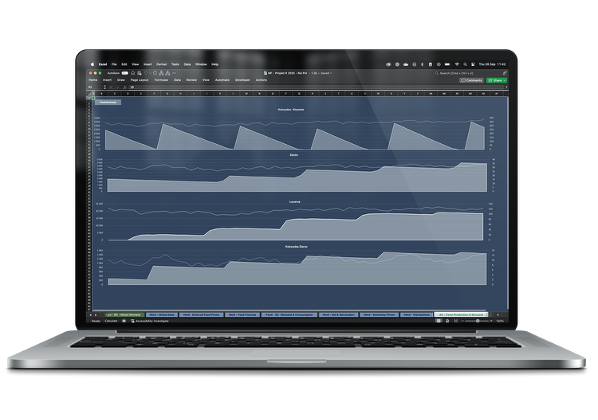
Herd – Organic Fertilizer Output
The Organic Fertilizer Output module is a key tool for planning and monitoring the production of natural organic fertilizers, such as manure and slurry, which come directly from animal husbandry.
This module provides comprehensive information on the quantities of organic fertilizers produced each month and day, enabling more precise farm management and minimizing the cost of purchasing synthetic fertilizers.
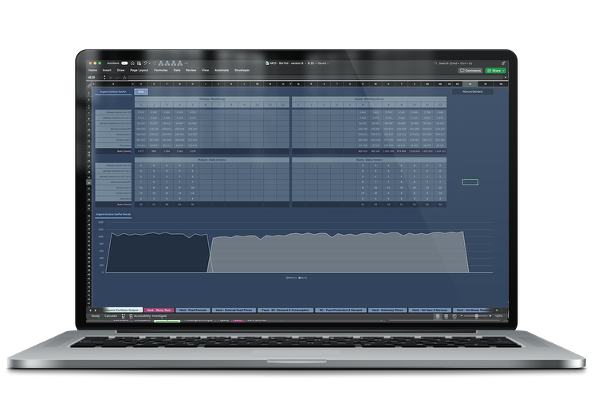
HERD: ORGANIC FERTILIZER OUTPUT – FUNCTIONALITIES
Precise Fertilizer Production Monitoring:
The module provides detailed data on the amount of manure (in kilograms) and slurry (in liters) produced each month. This allows the user to track monthly and daily fertilizer production levels from various animal groups, such as heifers, milking cows, and dry cows.
Daily Production Averages:
The module calculates daily manure and slurry requirements (in tons), allowing for more dynamic inventory management and day-to-day operational adjustments. The user can accurately determine daily fertilizer needs based on the number and classification of animals.
Integration with Herd Management:
The module is tightly linked to herd data, enabling precise calculation of fertilizer production based on the number and type of animals. For example, manure and slurry production for heifers, milking cows, and dry cows is dynamically updated according to herd size and production cycles.
Support for Fertilization Planning:
Information from the module can be used to plan organic fertilizer application in the fields, supporting sustainable soil fertility management. With precise data on available fertilizer quantity, the farm can make efficient use of natural resources and minimize the need to purchase additional chemical fertilizers.
Ease of Use for Sustainable Agriculture:
Module data helps users implement a sustainable agriculture strategy, where natural fertilizers from animal production can replace synthetic fertilizers. This gives the user full control over the quantity of fertilizer produced and allows for adjustment to the real needs of the field, supporting a more ecological and efficient approach to crop management.
HERD: VETERINARY SERVICES PRICES
The “Veterinary Services Prices” module enables comprehensive management and monitoring of veterinary service costs, such as vaccinations, preventive treatments, and disease therapy.
The module provides detailed insight into quarterly operating expenses related to herd health care, allowing for precise budget planning and evaluation of the cost-effectiveness of prevention and treatment practices.
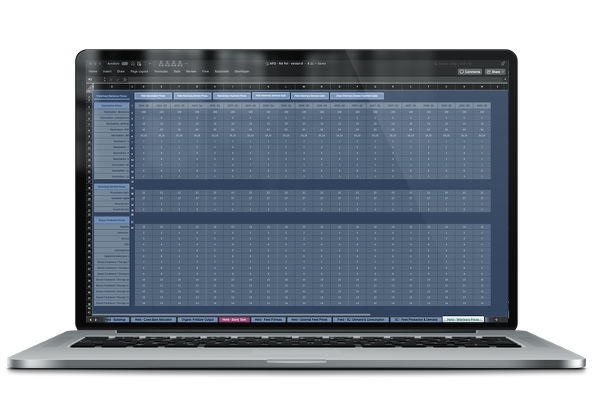
HERD: VETERINARY SERVICES PRICES – FUNCTIONALITIES
Accurate forecasts of veterinary expenses:
The user has full insight into future operational costs related to health care, making budgeting, optimization, and expense control easier.
Analysis of prevention and treatment costs:
The ability to compare expenditures on vaccinations with disease treatment costs allows assessment of the economic viability of preventive measures.
Monitoring changes over time:
The module enables quarterly expense analysis, allowing for identification of potential increases or decreases in costs and adjustment of the veterinary strategy on the farm.
With the “Veterinary Services Prices” module, the user can better manage herd health and make decisions based on actual veterinary cost data, increasing efficiency and profitability.
HERD: VETERINARY VACCINATIONS AND SERVICES
This tool enables precise management of vaccination and veterinary procedure schedules for cattle, based on animal age.
The module allows planning of health prevention and routine veterinary services, supporting herd health and productivity.
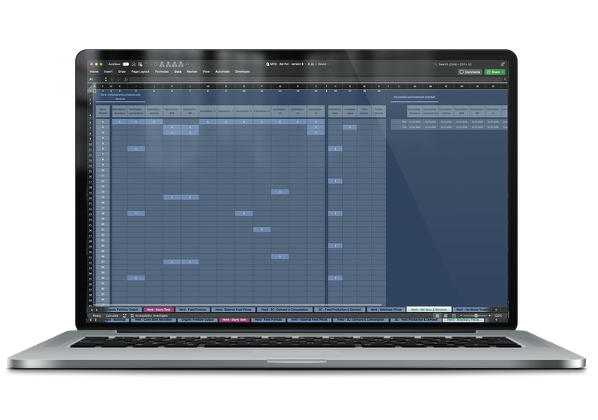
HERD: VETERINARY SERVICES PRICES – FUNCTIONALITIES
Vaccination Schedule
The module includes a detailed vaccination plan according to animal age, covering various vaccine types and their administration frequency:
Brucellosis
Scheduled vaccinations at specific months of life, repeated every few years to maintain immunity.
Leptospirosis, Anthrax, BVD, IBR
Precisely scheduled vaccination months to effectively prevent these diseases and increase herd health protection.
Additional vaccines
Enable flexible addition of vaccines as required by farm management or specific health needs.
Life cycle monitoring
The module automatically analyzes animal age and assigns proper vaccination and procedure cycles, so the user does not have to manually assign a schedule for each animal. The system automatically handles the start and completion of vaccination/procedure cycles, eliminating the need for manual tracking of age and health status for each animal.
Adapting to start and end dates
The module automatically matches the schedule to specific start and end dates for each animal group, allowing the user to accurately monitor when prevention cycles begin and when completions or pauses are scheduled.
HERD: VETERINARY SERVICES PRICES – BENEFITS
Precise prevention planning
The vaccination and veterinary service schedule tailored to animal age enables effective disease prevention and minimizes herd health risks.
Process automation
Automatic assignment of vaccination and treatment cycles eliminates the need for manual schedule management and reduces the risk of errors.
Cost optimization
Systematic vaccinations and preventive procedures help reduce disease treatment expenses, improving farm profitability.
Flexibility in veterinary service customization
The ability to add custom services and adjust the schedule allows for personalized veterinary care to match the herd’s unique needs.
Herd: Illness Treatment – Probability
The Herd – Illness Treatment – Probability module enables analysis of disease probability in the herd based on animal age and classification.
Based on age and classification data, the user can monitor the risk of certain diseases appearing, such as mastitis, ketosis, or bacterial infections.
The module provides percentage probability values of illness for specific animal classes.
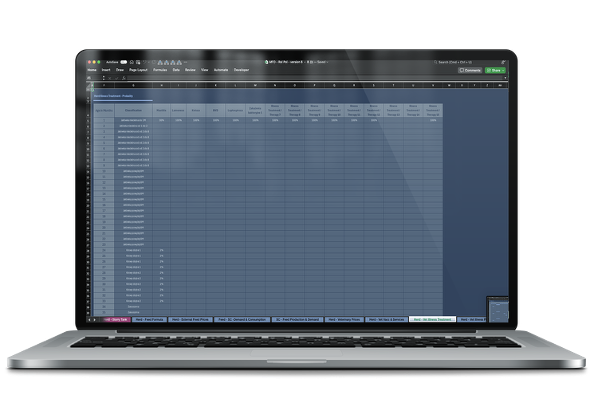
HERD: ILLNESS TREATMENT – PROBABILITY – BENEFITS
Risk assessment for each herd unit
The module tracks the probability of disease occurrence depending on the cow’s age and classification (non-pregnant heifer, milking cow, dry cow). This makes it possible to anticipate and respond to potential health problems.
Division by life stage
The module differentiates disease risks according to the animal’s life phase:
Non-pregnant heifers in various age groups (e.g., up to 1 month, from 1 to 2 months, etc.).
Milking cows divided into two types (milking cows 1 and milking cows 2), which allows accounting for disease risk differences related to the lactation stage.
Dry cows, where the risk may be lower but specific health threats exist related to preparation for the next lactation.
Age-based prediction
Each age group is assigned a percentage probability of occurrence for specific diseases.
Detailed disease data
The module covers a range of diseases and health issues, including:
- Mastitis,
- Lameness,
- Ketosis (metabolic disease),
- Infectious diseases such as BVD (bovine viral diarrhea), leptospirosis, or bacterial infections.
Additional therapies and treatments are assigned as numeric identifiers (e.g. IllnessTreatment / Therapy 7, 8, 9, etc.), which enables expanding the disease list with specific cases.
Forecasting veterinary interventions
The module can be used as a tool to support herd health management by identifying the most at-risk individuals, making it possible to plan appropriate preventive or therapeutic actions.
Sample uses:
Health prevention planning
The module allows for disease risk assessment in specific life phases, enabling implementation of relevant preventive measures, such as vaccinations or regular health checks.
Treatment cost optimization
Thanks to precise illness risk prediction, the farm can better manage treatment costs, planning future veterinary expenditures based on disease risk.
Herd health management
The module supports decision-making regarding animal rotation and organization of work on the farm by precisely defining those moments when disease risk is highest for specific age groups.
HERD: ILLNESS TREATMENT PLANNER
The Herd – Illness Treatment Planner module is used for comprehensive management of disease treatment schedules in the herd, enabling precise planning and monitoring of the frequency and periods of treatments for individual diseases.
This module is a key tool supporting herd health by effectively assigning veterinary resources and planning treatment costs.
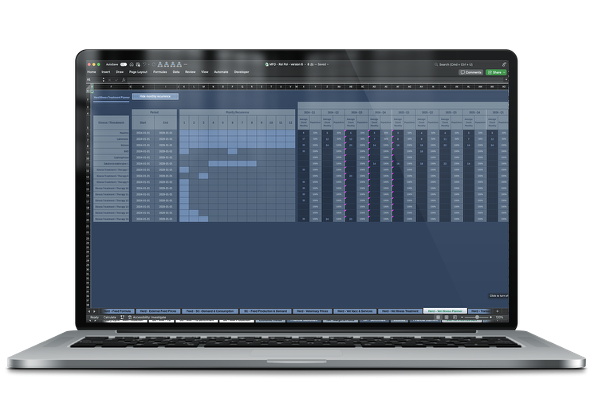
HERD: ILLNESS TREATMENT PLANNER – FUNCTIONALITIES
Defining treatment periods:
The user can set start and end dates for treatment of each disease unit (e.g., mastitis, lameness, ketosis). Specified periods allow flexible treatment management over time, which is crucial for maintaining animal health in the long term.
Treatment frequency planning:
The module enables monthly treatment frequency settings for each disease or therapy. These values can be adjusted to the herd’s specific health needs, e.g., monthly or every few months, depending on risk and requirements. The frequency function enables forecasting periodic treatment costs and better work organization.
Case count monitoring on a quarterly and annual basis:
The module allows analysis of the average number of disease cases in each quarter, with details on the number of animals requiring treatment during a given period. By viewing seasonal changes in case numbers, it is possible to more precisely manage resources and the veterinary budget.
Population analysis and treatment percentage forecasts:
The module shows what percentage of the herd population is at risk for each disease and what portion is being treated during each period. Information on forecasted treatment percentages lets users assess the impact of diseases on the entire herd, helping in decisions about potential preventive measures.
Personalized treatment plans for various diseases and therapies:
The user can create individual treatment schedules for different diseases, adjusting treatment frequency to each disease’s specific requirements.
Tracking operating costs:
The module generates treatment cost forecasts in relation to case numbers and treatment frequency. This allows precise planning of expenses and allocation of the veterinary budget.
Herd: Insemination Prices
The Dairy Cycle – Insemination Prices module supports planning and analysis of costs associated with insemination in the herd, allowing users to track the costs of individual types of insemination and related additional procedures.
This is a key module for managing reproduction expenses, enabling better budget planning and more effective management of the herd’s reproductive cycles.
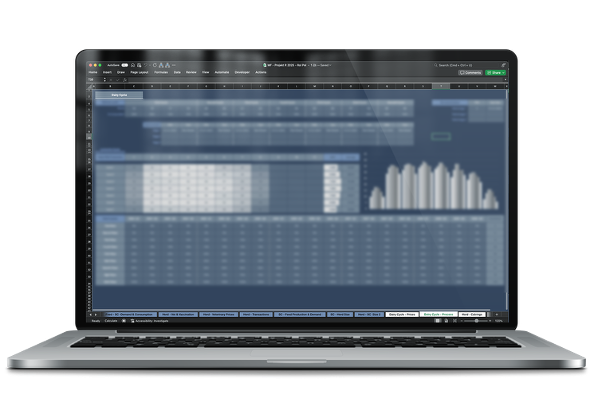
HERD: Herd: Insemination Prices – Functionalities
Tracking Insemination Costs in Various Reproductive Cycles:
The user can enter and monitor costs for individual insemination cycles, enabling adjustment of the insemination strategy according to herd needs and budget.
Recording Additional Insemination-Related Procedure Costs:
The module allows input of not only insemination costs themselves but also the costs of additional procedures, such as:
- Insemination Procedure: Cost of performing the insemination procedure.
- Insemination Medicine: Costs of medicines used during insemination.
- Insemination Analysis: Costs of diagnostic analysis and preparation for insemination.
- Insemination Monitoring: Cost of monitoring cow health before and after insemination.
- Insemination Additional: Other extra costs resulting from atypical procedures or requirements.
Quarterly Analysis of Insemination Operating Expenses (OpEx):
The module summarizes operating expenses (OpEx) for insemination on a quarterly basis, enabling expenditure comparison between periods and identification of quarters with the highest costs.
Budget Planning:
The module allows the user to easily enter costs related to different insemination types and additional procedures, simplifying insemination budget planning for upcoming quarters.
Cost Change Monitoring:
The user can regularly update and track insemination costs, quickly respond to price changes, and adjust budgets and breeding plans as needed.
Operating Expense Analysis:
With quarterly operating expense summaries, the user can easily analyze the impact of insemination costs on total operating expenditures and adjust the herd management strategy if needed.
HERD: Dairy Cycle
The Dairy Cycle module supports planning of reproductive cycles and milk production in the herd, enabling management of insemination schedules, lactation, and forecasting herd losses.
The user can define average milk production values for the herd and plan reproductive activities, which allows optimization of production processes and increasing efficiency.

HERD: DAIRY CYCLE – FUNCTIONALITIES
Planning Estrous and Insemination Cycle:
Estrous Cycle:
The module enables monitoring of estrous cycles and setting up consecutive insemination cycles, from the first to the seventh. The user has full control over the reproduction schedule, allowing precise planning and adjustment of insemination dates.
Insemination Technologies:
Ability to choose between different insemination technologies (e.g., conventional or sexed insemination). This lets the user match the insemination method to the herd’s development strategy.
Repeat Insemination Rate:
The user can set a repeat insemination rate, which is crucial for monitoring reproductive efficiency and increasing conception rates in the herd.
Automatic Calculation of Calvings and Costs:
The module automatically calculates calving dates based on entered insemination cycle data and the chosen technology. This provides users with forecasts of calving dates and resulting costs, taking into account both semen type and the applied technology (e.g., conventional insemination or advanced techniques). The system automatically calculates costs for each option, enabling analysis and selection of the most cost-effective solutions.
Based on this data, the module generates forecasts, allowing efficient planning and growth prediction for the herd. Each calving date forecast is linked to a cost estimate, which includes not only the insemination procedure but also all costs associated with semen type selection and additional costs resulting from the technology used.
For example, choosing sexed semen may generate higher unit costs, but at the same time increases the likelihood of heifer births, which can have a significant impact on the long-term productivity and structure of the herd.
HERD: DAIRY CYCLE – DEFINING THE LACTATION CYCLE:
Average Milk Production:
The user defines average milk yield values for each lactation cycle in the herd, rather than tracking individual daily production. These values cover lactation periods from the first to the seventh cycle, enabling general milk production forecasts.
Productivity Analysis:
User-defined averages allow estimation of total milk production across a month or quarter, which assists in resource planning and feed optimization for the herd.
Herd Loss Forecasting:
The module allows herd loss forecasting in specific waves (from first to ninth), where each wave represents a certain animal age and expected loss percentage in a given quarter. The user can enter percentage values for each wave, enabling better prediction and resource management.
Loss Analysis by Wave:
Loss forecasts are assigned to specific months of a cow’s life, supporting better planning, herd management, and quicker preventive actions to minimize losses.
HERD: DAIRY CYCLE – SAMPLE USE CASES:
Optimization of Insemination Schedule:
The module allows precise planning of estrous cycles and selection of insemination technologies, helping maximize reproduction efficiency and increase herd growth.
Milk Production Forecasting:
Defining average milk production for each cycle allows the user to plan feed demand and forecast milk income.
Herd Loss Management:
The ability to forecast losses in specific age waves allows natural herd attrition to be anticipated, facilitating resource planning and preventive measures such as improved health management.
The Dairy Cycle module provides a comprehensive tool for planning reproductive cycles and milk production in the herd, enabling management of both insemination scheduling and forecasting of milk production and herd losses. This lets the user efficiently manage resources and make better-informed herd development decisions, positively impacting the stability and profitability of milk production.
Herd: Calvings
The Calvings module enables comprehensive tracking and analysis of calving cycles and natural losses in the herd, providing the user with detailed forecasts and herd replenishment indicators.
The module takes into account various types of insemination (sexed and non-sexed) and allows monitoring of their effects in terms of the number of heifer and bull births in specific quarters.
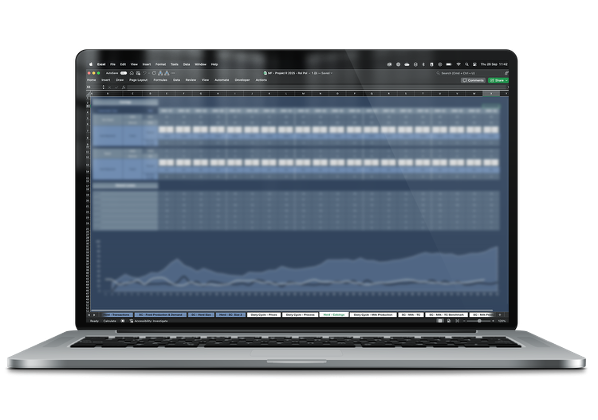
HERD: CALVINGS – FUNCTIONALITIES
Calving Forecasts by Semen Type:
The module tracks the number of calvings from insemination with non-sexed and sexed semen. For each quarter, figures for heifer and bull births are calculated, with the option to customize the ratios for each scenario.
Herd Replenish Factor:
The user can set the herd replenish factor to monitor how well new calvings meet the herd replenishment needs. This supports effective management of structural herd growth, maintaining a desirable balance between heifers and bulls.
Monthly Average:
For each insemination type (sexed and non-sexed), the system calculates the average monthly number of calvings. These values enable better planning of the future herd size and estimation of productive resources.
Natural Herd Losses:
The module also includes a section for tracking natural losses in the herd, allowing the user to monitor animal loss across reproductive cycles. These values are provided quarterly, supporting identification of patterns and potential health or production issues in the herd.
Production Cycle Analysis:
The user can analyze losses within different cycles, such as cycles 1–5, including natural losses. The module provides detailed data that aids optimization of the animal life cycle, monitoring loss rates, and risk analysis for each age group.
Flexible Data Entry:
The module is flexible, allowing the user to input, modify, and track data on various insemination types and natural losses, adapting to specific herd management needs. These values can be edited dynamically, enabling adjustments for changes in breeding practices or management strategies.
Herd: Milk Production
The Milk Production module is an advanced tool for monitoring and forecasting quarterly milk production, which incorporates “virtual splits” for cow populations.
With this feature, the user can analyze the impact of different scenarios—such as introducing new milking technology or production drops caused by disease—on productivity and financial results.
The Milk Production module is designed to automatically calculate average daily milk production, integrating data from other modules, primarily Dairy Cycle and Inventory.
This ensures accurate production forecasts based on the individual yield of each cow, as well as the age structure and size of the herd.
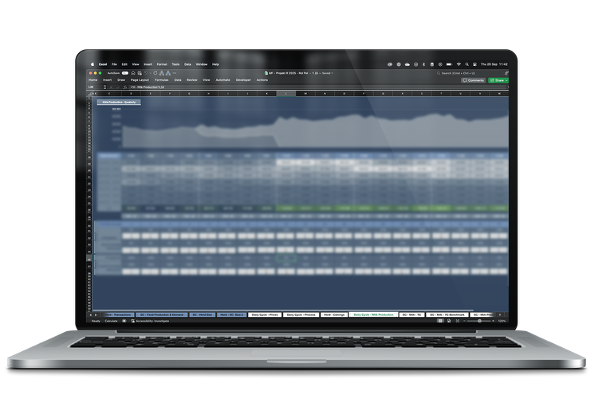
The Milk Production – Quarterly module provides the user with a complete overview of milk production with the ability to perform precise simulations of different technological and health scenarios.
By automatically recalculating the average daily production according to the cows’ age and lactation cycle, the module ensures accurate forecasts of production and revenue, supporting farm planning and financial management.
The introduction of virtual populations additionally enables analysis of the impact of new technologies and management strategies on the efficiency and profitability of milk production.
HERD: MILK PRODUCTION – FUNCTIONALITIES
Automatic Calculation of Average Daily Production:
The module uses data on cows’ milk yield depending on age and lactation cycle from the DairyCycle module to automatically calculate the average daily milk production. Based on this data, the system calculates milk output for each cow by age and cycle.
Integration with the Inventory Module:
The module automatically incorporates information on herd size and age structure from the Inventory module. Thanks to this, milk production is precisely calculated based on the actual number of cows of each age and lactation cycle, ensuring an accurate reflection of the herd’s current productive performance.
Quarterly Milk Production Forecast:
Based on daily output, the module generates quarterly forecasts, which enable effective planning of production and sales. The user gains a full view of the expected milk quantity for each quarter—accounting for seasonal fluctuations and herd dynamics.
Virtual Populations & Technological Scenarios:
The module allows the definition of virtual populations—supporting simulation of various production scenarios, including:
- Introduction of new milking technologies—analyze how new technology affects yield and profitability.
- Impact of diseases on milk production—assess potential production drops caused by herd health issues.
With this functionality, the user can anticipate which technological or managerial changes may deliver the best results, minimizing the risk associated with possible changes.
Automatic Revenue Calculation:
The module computes revenue based on forecasted milk production, enabling precise monitoring of financial results. With quarterly revenue forecasts, users can better plan budgets and optimize operating costs.
Performance Monitoring for Each Production Cycle:
The module tracks milk yield for every lactation cycle, enabling identification and optimization of weaker or more efficient cycles—supporting production management and optimal utilization of the herd’s potential.
Analysis of Herd Status Changes:
Thanks to integration with the Inventory module, the module dynamically responds to changes in herd size (e.g., cow growth or loss), allowing continuous adaptation of production forecasts to the farm’s real situation.
Herd: Technical Cost – Milk Production
The Technical Cost – Milk Production module is an advanced tool for monitoring and analyzing the technical costs related to milk production on the farm. It compiles operational costs and production results for each cycle, enabling the user to track performance and identify areas in need of optimization.
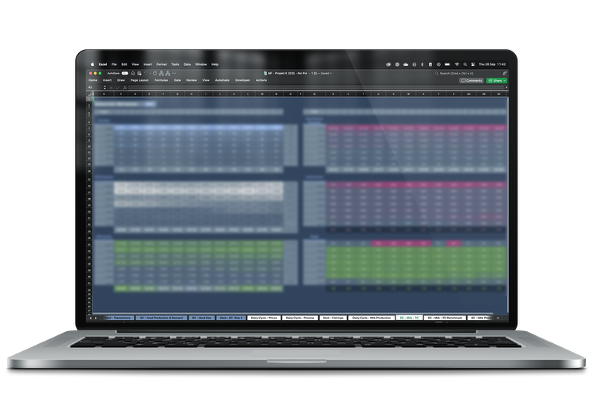
HERD: TECHNICAL COST – MILK PRODUCTION – FUNCTIONALITIES
Herd Size Monitoring:
The module tracks herd size across production cycles, enabling analysis of productivity by age and cycle structure. This supports herd management strategy adjustment and effective population monitoring over time.
Milk Production Analysis:
The system calculates monthly milk production for each cycle, factoring in yield differences by production cycle. This enables accurate short- and long-term milk output forecasting.
Milk Production Revenue:
The module forecasts revenue from milk, considering price variability and output per cycle. Users can track generated revenue and compare it to technical costs for ongoing profitability assessment.
Feed and Operating Costs:
The system records feed costs (internal and external) and other operational costs—such as straw, energy, fuel, veterinary, insemination, and insurance—enabling full operational cost management and expense tracking for milk production.
Margin and Profitability Analysis:
The module calculates margin, considering the difference between revenue and technical costs. This enables users to track production profitability across cycles and identify the most profitable periods and areas for optimization.
Automated Technical Cost Calculations:
Technical costs are computed automatically based on herd size, feed consumption, energy, fuel, and other resources. Users can track technical costs and analyze variability relative to herd structure and forecasted production.
Technical Cost Calculation Per Liter of Milk:
The module allows detailed calculation of technical costs per liter produced, supporting cost-efficiency analysis. Users can precisely determine profitability per production unit and adjust production strategies as needed.
Profitability and Margin Forecasts for Each Cycle:
The system forecasts margins and profitability based on the difference between revenue and operating costs for every production cycle. Profitability analysis enables identification of the most profitable production periods and informs management strategy adjustments.
HERD: TECHNICAL COST – MILK PRODUCTION BENCHMARK
The Technical Cost – Raw Milk module is an advanced tool for analyzing technical costs related to raw milk production, enabling detailed tracking of expenditures and revenues associated with every aspect of the process.
It is designed so that users can precisely manage costs and efficiently analyze production profitability over months and years, accounting for any process changes—from sowing all the way through to the production of raw milk.
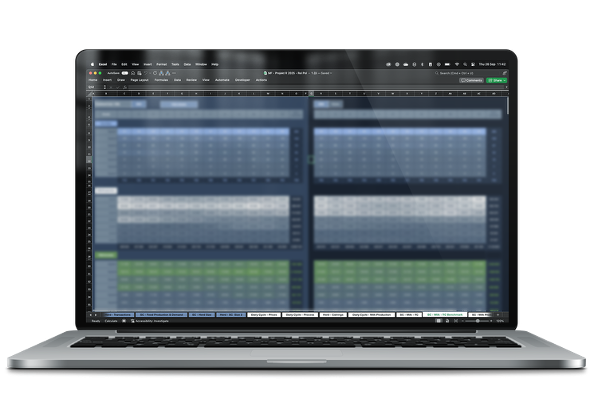
HERD: TECHNICAL COST – MILK PRODUCTION BENCHMARK – FUNCTIONALITIES
Detailed monitoring of costs and revenues:
The user can track all operational expenses related to milk production, such as feed, energy, straw bedding, fertilizers, insemination, and veterinary services. Additionally, the module gathers milk production revenue data, enabling full financial analysis of each production cycle.
Profitability analysis of production:
With the ability to monitor results on a monthly and yearly basis, the module supports long-term profitability analysis. The user can identify periods of higher or lower profitability and make changes to the production strategy as needed.
Incorporation of technological and process changes:
This module is designed with farm dynamics in mind—it allows process changes such as new feeding methods, milking technology updates, or insemination system optimization. This lets users simulate the effects of improvements and analyze their impact on costs and profit margins.
Comparison of results with previous years:
The module includes functionality for comparing results from previous years or any selected year. This lets users see how operational and technological changes affect the profitability and margins achieved in milk production; users can easily assess which decisions brought the best financial results.
Rapid strategy adjustment:
The module is flexible and supports financial simulations, allowing users to quickly respond to changing market or production conditions. As a result, the tool helps optimize costs and maximize margins while accounting for the specifics of each farm’s operation.
EFAR
The EFAR module is an advanced tool for managing a farm’s fixed assets, providing control and analysis of asset values from both an accounting and market standpoint. EFAR’s functionalities cover full asset inventory, allowing for investment, depreciation, and modernization tracking.
Main functionalities:
- Inventory of fixed assets and investments.
- Separation of capital and operating costs related to asset maintenance.
- Analysis of the impact of investments on the book and market value of the enterprise.
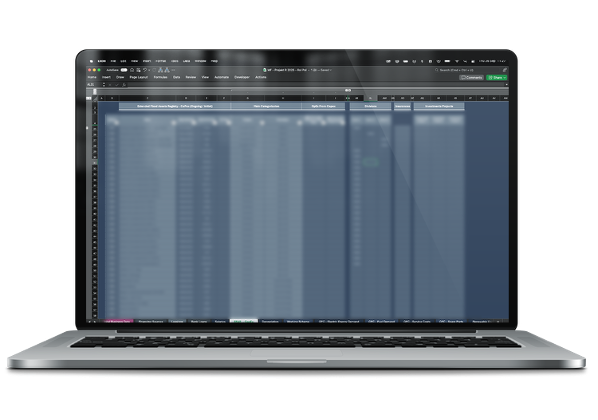
The EFAR (Extended Fixed Assets Register) module is designed to capture assets that are not included in the standard Fixed Assets Register.
Its purpose is to monitor costs associated with these positions and include them in the calculation of the enterprise’s adjusted net assets.
Thanks to this module, users can more precisely manage values that influence the true worth of the enterprise, even if they are not formally recognized in traditional accounting.
EFAR – FUNCTIONALITIES
Fixed Asset Registration:
- Recording fixed assets with their basic data (purchase cost, acquisition date, service life).
- Ability to assign assets to relevant categories (buildings, machinery, equipment).
- Automatic calculation of book depreciation and net asset value.
Market and Book Value Analysis:
- Dynamic estimation of market value of fixed assets based on market parameters.
- Comparison of book value with market value for better understanding of an asset’s current value.
- Setting future asset values under different market scenarios.
Reporting and Visualization:
- Creating reports on the status and value of fixed assets and their impact on financial indicators.
- Visualization of asset costs and values under various economic scenarios.
- Summarizing operating and capital costs for management, enabling rapid decision-making.
Future Asset Valuation Scenarios:
- Ability to simulate asset values based on assumptions about inflation, market price changes, and operating costs.
- Dynamic scenario analysis of investment impact on future company value.
- Evaluation of profitability and return on investment for each scenario.
Depreciation
The Depreciation module enables comprehensive management of asset depreciation, which is crucial for long-term asset management strategy and accuracy in financial analysis.
This module allows not only for precise monitoring of depreciation costs in accounting terms but also for analyzing the impact of depreciation on a company’s operating and financial results.
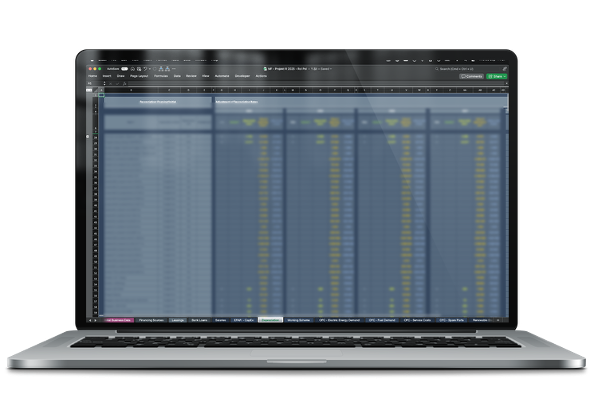
DEPRECIATION – FUNCTIONALITIES
Depreciation Method Selection
The ability to choose the depreciation method for each asset (straight-line, declining balance, or other).
Investment Adjustment
Automatic updates of depreciation for assets that have been improved or increased in value through investments.
Impact on Financial Results
Calculation of depreciation costs and their direct impact on the operating result and book valuation.
Net Asset Value Adjustment
Depreciation Reporting
EFAR – CAPEX
The CaPex module in EFAR manages all investment expenditures that impact the development and modernization of the farm.
It allows for planning and profitability analysis of future investments, such as the purchase of machinery, construction of buildings, or installation of new technologies.

EFAR – CAPEX – FUNCTIONALITIES
- Planning investment expenditures by year, with dynamically calculated financial results for the enterprise.
- Return on investment analysis and impact on enterprise value.
- Ability to dynamically model investment scenarios in response to market conditions.
EFAR MODULE OFC (OPEX FROM CAPEX)
This module is essential for planning and managing business operations and investment processes, allowing users to model operating costs related to asset utilization with additional OFC-style modules, such as:
- energy requirements,
- fuel,
- maintenance,
- replacement of spare parts,
- insurance.
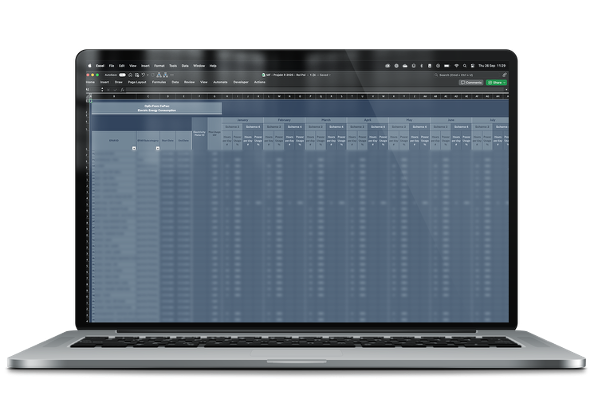
EFAR – CAPEX & OFC FUNCTIONALITIES
Investment Management and Analysis:
- Support for investment projects as new assets or capitalization of existing ones, with division into six investment stages.
- Modeling investment costs for new projects and their impact on asset value.
Monitoring investment completion at each stage and analyzing impact on the company’s long-term strategy
Asset Operational Effects (OpEx):
- Calculation of operating costs related to fixed asset utilization.
- Analysis of energy consumption, fuel needs, maintenance costs, and spare parts.
- Assignment of operating costs to appropriate sections of the financial model for comprehensive OpEx analysis.
OFC: Fuel Consumption
The OFC OpEx From CaPex: Fuel Consumption module is a tool designed for monitoring and analyzing fuel consumption by specific agricultural machines within the enterprise.
It provides a comprehensive overview of operational costs associated with energy use across different areas of farm operations.
With this module, the user can precisely track energy consumption and manage the budget more effectively—a crucial factor for cost optimization.

OFC: FUEL CONSUMPTION – FUNCTIONALITIES
Tracking fuel usage for various vehicle and machine types:
The module enables monitoring fuel consumption individually for each machine and vehicle, regardless of type (tractors, delivery trucks, loaders, etc.), allowing detailed analysis of fuel costs by equipment category and application.
Adjusting work schedules to monthly fuel needs:
It allows consideration of different work schedules for each machine, accounting for daily working hours, which is key for seasonal agricultural work where fuel use may vary significantly throughout the year.
Modeling fuel efficiency:
For vehicles used in long-distance transport, the module supports input of fuel efficiency indicators (fuel use per 100 km), helping users better assess fuel costs based on monthly travel distances.
Fuel type tracking:
The module enables input of fuel type (e.g., Diesel, CNG), allowing analysis of costs based on specific market prices for each type, so users can monitor fuel spending in more detail—crucial given volatile fuel prices.
Fuel consumption forecasting:
By entering work hours and monthly distances, the module can forecast monthly fuel needs, supporting operational cost planning and budgeting.
Cost analysis by department:
The module provides the option to assign fuel costs to various departments, ensuring precise tracking and allocation—useful for cost accounting and managing expenses across farm sectors.
OFC: FUEL CONSUMPTION – BENEFITS
Precise fuel cost control:
The module enables ongoing monitoring of fuel expenditures and identification of savings opportunities.
Operational optimization:
By analyzing fuel use according to work schedule and efficiency, users can optimize machine work plans to lower costs.
Budgeting support:
The module allows for fuel need forecasting throughout the year, supporting budget creation and comparison of actual vs. planned costs.
Flexible cost allocation:
Assigning fuel costs to particular departments enables better overall expense management for the farm.
The OpEx From CaPex: Fuel Consumption module supports comprehensive, precise fuel cost management, tailored to the specifics of agricultural operations and equipment diversity.
EFAR MODULE OFC – SERVICE
This module is an operational cost management tool focused on recording and forecasting service and maintenance costs for fixed assets on the farm.
In particular, it lets users assign service costs to specific assets, such as agricultural machines, vehicles, and animal management equipment, and track these expenses month by month.

OFC: SERVICE – FUNCTIONALITIES
Assignment of service costs to assets:
The module allows detailed assignment of service costs to individual fixed assets, such as tractors, trailers, cattle management devices, or agricultural machines. Each piece of equipment is tagged with a unique ID to enable precise tracking of its maintenance costs.
Service schedule management:
With start and end date features for each asset, users can easily manage annual service schedules, aligning them with planned seasonal work. The module also accounts for cost variability across the year for optimized maintenance spending.
OFC: SERVICE – BENEFITS
Better control of service costs:
The module enables detailed tracking of servicing expenses, making budget control easier and highlighting areas for potential savings.
Optimization of service planning:
By forecasting service expenditures and assigning costs to months, the module supports optimal maintenance planning, minimizing risk of expensive downtime.
Support in cost allocation:
Dividing costs into departments allows for precise allocation of spending, supporting whole-farm budget management.
OFC: Spare Parts
The OFC OpEx From CaPex: Spare Parts module is an integral part of operational cost management related to purchasing and maintaining spare parts for fixed assets on the farm.
This module enables accurate tracking of expenses for spare parts essential to keeping equipment and machinery in good technical condition, which is crucial for uninterrupted operational processes.

OFC: FUEL CONSUMPTION – BENEFITS
Tracking spare part costs by asset:
Every expense for spare parts is assigned to a specific fixed asset, allowing precise monitoring of expenditures for individual machines and equipment, such as tractors, trailers, livestock management devices, or delivery vehicles.
Accurate spare part cost monitoring:
The module enables detailed tracking of spare part expenses, providing better budget control and supporting forward-looking expense planning.
Purchase optimization:
By forecasting costs and scheduling purchases, the module improves spare parts management and reduces the risk of downtime due to unavailable key parts.
OFC: ELECTRIC ENERGY CONSUMPTION
The OFC OpEx From CaPex: Electric Energy Consumption module is a tool designed to monitor and analyze the electric energy consumption of individual devices and machines within the enterprise.
It provides a comprehensive overview of operating costs associated with energy consumption across various areas of business activity.
With this module, the user can accurately track energy usage and manage the budget more effectively, which is crucial in the context of cost optimization.

OFC: ELECTRIC ENERGY CONSUMPTION
Device Registration and Classification:
Each device or machine consuming electric energy is registered in the module and assigned to an appropriate category as well as a unique identifier (ID), such as EFAR ID and subcategory. This enables detailed tracking of operating costs for each piece of equipment, facilitating analysis and cost allocation.
Usage Date Range:
The module allows you to set the start and end date of usage for each device, enabling precise inclusion only for periods when the device is actively used. This ensures costs are assigned more accurately to their respective periods and allows for better future spending planning.
Maximum Power and Usage Profile:
For each device, its maximum power (kW), daily operating hours, and the percentage level of power utilization in various operating schemes are defined. This allows the user to analyze costs depending on the intensity of use for individual machines.
Monthly Analysis and Operating Schemes:
The module allows input of energy consumption data for each month with a distinction for different operating schemes (e.g., Scheme 3 and Scheme 4). This enables identification of seasonal patterns in energy consumption and better management of operating costs depending on the time of year.
Cost Allocation by Divisions and Projects:
Energy consumption can be assigned to various divisions, making it possible to analyze costs in detail across specific areas of farm operations.
The module also supports the allocation of costs to specific investment projects, enabling profitability assessment of particular investments through precise monitoring of energy costs associated with these projects.
OFC: ELECTRIC ENERGY CONSUMPTION – BENEFITS
Precise Energy Cost Control:
The module allows detailed monitoring of electric energy costs at the level of individual devices. This enables better budget planning and reduction of unnecessary expenses.
Optimization of Seasonal Operations:
With the capability for inputting detailed data at the monthly level, the user can better manage energy consumption in the context of seasonal fluctuations in agricultural operations.
Support for Investment Project Analysis:
Assigning energy costs to specific projects allows more precise assessment of individual investment profitability, which is crucial for making capital allocation decisions.
Increased Management Efficiency:
Thanks to the module, the user has full insight into energy consumption and can make informed decisions regarding energy efficiency, which is especially important in the face of rising energy costs and pressure for sustainable development.
Precise Energy Cost Control:
The module allows detailed monitoring of electric energy costs at the level of individual devices. This enables better budget planning and reduction of unnecessary expenses.
Optimization of Seasonal Operations:
With the capability for inputting detailed data at the monthly level, the user can better manage energy consumption in the context of seasonal fluctuations in agricultural operations.
Support for Investment Project Analysis:
Assigning energy costs to specific projects allows more precise assessment of individual investment profitability, which is crucial for making capital allocation decisions.
Increased Management Efficiency:
Thanks to the module, the user has full insight into energy consumption and can make informed decisions regarding energy efficiency, which is especially important in the face of rising energy costs and pressure for sustainable development.
RES (RENEWABLE ENERGY SOURCES)
The RES (Renewable Energy Sources) module focuses on the financial and technical analysis of photovoltaic (PV) installations.
The entered data includes installation details, capacity, commissioning date, and the sunlight coefficient. Based on this information, the module forecasts energy production, comparing it with energy demand data from the OFC – Energy Demand module.
Energy prices can be dynamically modeled using the Market Trend module, allowing for accurate forecasts of costs and savings resulting from PV implementation.
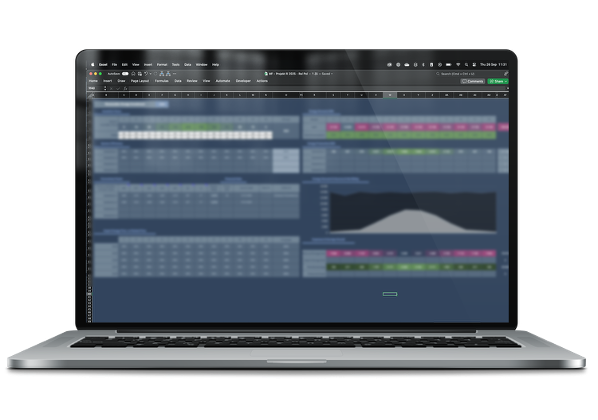
The RES module is a tool designed for modeling and analyzing the costs and benefits associated with the use of renewable energy sources such as photovoltaic (PV) systems.
It allows the user to track and assess the effectiveness of investments in renewable energy sources and their impact on the operational costs of the farm.
With this module, a more sustainable structure of energy costs can be achieved, which is important in the context of reducing dependence on traditional energy suppliers and lowering greenhouse gas emissions.
RES (RENEWABLE ENERGY SOURCES) – FUNCTIONALITIES
PV Installation Configuration:
The module allows entry of detailed parameters regarding the photovoltaic installation, such as commissioning date, installed capacity (kW), panel orientation, system efficiency, and sunlight data. This enables an accurate representation of each installation’s specifics and its potential energy production.
Energy Production Modeling:
By entering data on sunlight and the solar-to-electricity conversion factors, the module calculates monthly and annual energy production from PV installations. This makes it possible to forecast how much energy will be produced and, consequently, what percentage of the farm’s energy demand will be covered by renewable sources.
Cost and Savings Analysis:
The RES module enables precise comparison of the costs of energy obtained from traditional sources with those related to renewable energy. This allows the user to analyze savings resulting from investment in the PV system and to predict the payback period.
Integration with the OFC – Energy Demand Module:
The RES module is linked with the OFC – Energy Demand module, which models the farm’s energy needs. Thanks to this integration, it is possible to accurately compare PV system energy production with the farm’s actual consumption, assess whether
OPEX
The OpEx module provides a comprehensive, integrated view of operating expenses, allowing users to better understand cost structure and make more informed financial decisions. The integration of automatic forecasting with budgetary costs ensures complete coverage of all operational aspects of the business and enables precise financial control.
With the OpEx module, operating cost management becomes significantly more efficient and tailored to the specific needs of the enterprise, ensuring financial stability and facilitating long-term planning.
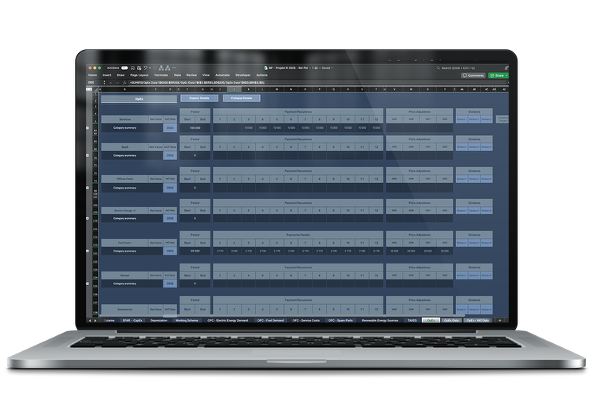
OPEX – FUNCTIONALITIES
The OpEx module is designed to integrate data from various financial modules, enabling a complete overview of operational costs at the enterprise level. It is based on two main categories of costs:
Costs Automatically Calculated by the Model:
Expenditures in this group are forecasted within other dedicated modules, such as the Cultivations module. For example, costs related to corn production are calculated based on the planned cultivation schedule and transferred to the OpEx module. This enables detailed tracking and control of costs related to each stage of production. Other modules, such as fertilization planning, calculate the costs of materials and services associated with agricultural activities.
These costs are dynamically updated and reflected in the OpEx module, providing a comprehensive analysis of operational expenditures.
Budgeted Costs:
The OpEx module also serves a budgeting function for expenses not calculated by the model. This mainly concerns administrative and business costs that do not have a direct impact on production, but are necessary for business operations. Examples of such expenses include accounting services, business consulting, or legal services.
Information about these costs has been obtained through additional OMS (Operations Management System) software, which enables precise data entry and control of expenses included in the budget only.
Cost Management and Tracking:
The module allows users to monitor costs in real time, taking into account seasonality and the cyclical nature of expenditures, which enables more accurate planning and management of financial liquidity.
Forecasting and Analysis:
Thanks to dynamic data integration, users can analyze changes in costs over several years and predict their impact on total operating expenditures.
Cost Allocation by Area and Project:
The module allows costs to be assigned to different divisions (e.g., Division 1, Division 2) and investment projects, facilitating cost analysis in the context of the enterprise’s strategic objectives.
Inclusion of Price Adjustments:
The module provides a function for adjusting prices based on inflation forecasts or other economic indicators, making expense planning more realistic.
TAXES
The TAXES module is an advanced tool for detailed tracking and analysis of tax burdens across various areas of farm operations.
This module provides users with full insight into current rates and contributions, enabling precise planning and control of tax and contribution costs associated with the operations of the agricultural enterprise.
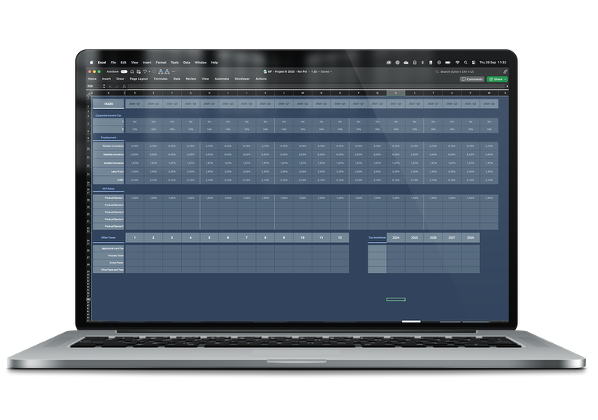
TAXES – FUNCTIONALITIES
Corporate Income Tax
Taxes and Contributions Related to Employment:
The module includes detailed rates for insurance contributions and funds related to employment, such as:
- Pension insurance
- Disability insurance
- Accident insurance
- Labor Fund
- FGŚP
VAT Rates
The TAXES module enables tracking of various VAT rates applied in the enterprise. For easier analysis, VAT rates are divided into several categories.
Other Taxes and Fees:
This section includes taxes and fees such as:
- Agricultural land tax
- Real estate tax
- Excise duty and other local and specific fees related to business activity
The module allows the user to adapt these taxes and fees to the individual needs of the farm, enabling precise planning of annual and quarterly tax obligations.
Tax Reliefs
The module also features the inclusion of tax reliefs, allowing for analysis of potential benefits from available exemptions. Users can track reliefs over the years, supporting long-term financial planning.
SALARIES
The Salaries module is designed to enable detailed management of employee compensation, divided by quarters and years.
Users can monitor salaries at the position level, both within the central structure and across individual departments.
The system allows specifying the number of employees in each position as well as their individual salaries, making it possible to perform precise calculations related to the salary budget on a quarterly and annual basis.

SALARIES – KEY ELEMENTS
Division by Departments:
The module also includes the functionality to account for tax reliefs, allowing for the analysis of potential benefits from available exemptions. Users can track reliefs over time, which supports long-term financial planning.
Dynamic Personnel Management:
Users can make changes to the number of employees in various positions (e.g., adding or removing employees in a given position in a specific quarter), allowing flexible adjustment of the employment structure to current needs.
Salary Cost Analysis:
Salary budget forecasting: The module supports long-term planning through salary forecasts for upcoming years, which is useful for preparing the operating budget.
Salary Budget Forecasting:
The module supports long-term planning through salary forecasts for upcoming years, which is useful for preparing the operating budget.
Finance Core
The Finance Core section focuses on the most important financial aspects related to share capital, supplementary capital, and shareholder loans.
It enables not only an analysis of the current financial structure but also the planning of future capital transactions between partners or potential investors.
As a result, the Finance Core section forms the foundation of financial management in the enterprise, with the ability to simulate incremental capital increases, allowing for precise financial planning and supporting strategic decision-making.
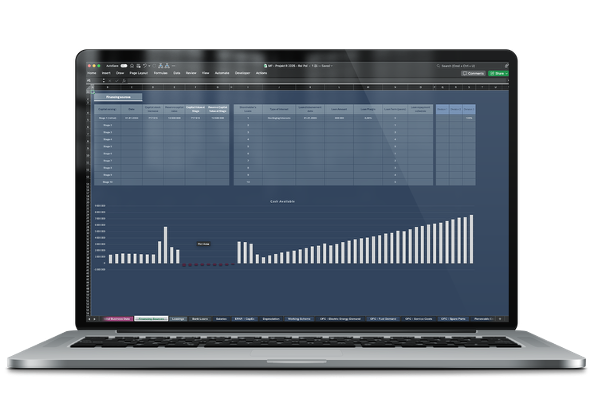
This module is designed for flexibility—it enables capital simulations and forecasts the impact of various funding sources on ownership structure and financial ratios.
This allows users to decide on the optimal way to raise capital for future investments, without overburdening the company with external debt.
FINANCE CORE – FUNCTIONALITIES
Share Capital:
- Monitor current share capital.
- Plan and simulate future capital increases.
- Forecast the impact of capital increases on ownership structure.
Supplementary Capital:
- Track current supplementary capital in the company.
- Analyze the potential of allocating supplementary capital for growth or to support operating activities.
- Simulate supplementary capital utilization in various investment scenarios.
Shareholder Loans:
- Register loans granted by shareholders and analyze their impact on capital structure.
- Plan repayment schedules with flexible options.
- Assess the effect of shareholder loans on financial ratios, including debt and liquidity metrics.
Capital Transactions:
- Support for simulation and modeling of capital transactions between partners.
- Ability to plan gradual capital increases to attract new investors or benefit current shareholders.
- Analyze the impact of capital transactions on future ownership structure and enterprise development strategy.
BANK LOANS
The “Bank Loans” module enables comprehensive management of the farm’s credit liabilities. Users can define lending conditions, including interest rate, repayment schedule, and refinancing dates.
The module automatically calculates debt servicing costs and forecasts the impact of loans on the financial situation in subsequent years.
Thanks to integration with other financial sections, the Bank Loans module provides a complete picture of financial liabilities and their effect on cash flow.
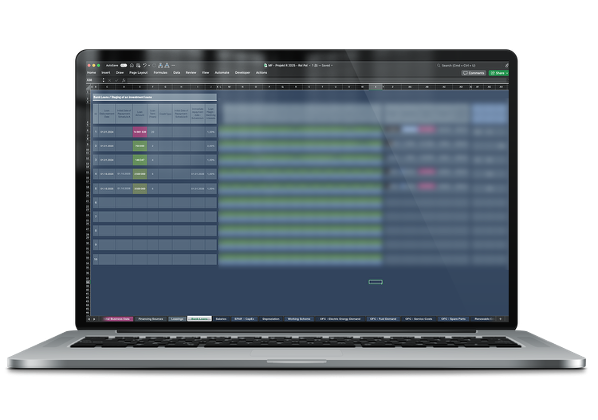
BANK LOANS – FUNCTIONALITIES
Analysis of Impact on Liquidity and Financial Results:
- Automatic calculation of the impact of loan installments on the company’s cash flows.
- Assessment of the effect of loan costs on EBITDA, net profit, and debt ratios.
- Simulation of the impact of new loans on financial liquidity, helping to plan optimal timing for securing financing.
Credit Scenarios:
- Ability to create various repayment scenarios depending on changes in interest rates or repayment schedules.
- Credit risk analysis by simulating interest rate increases and assessing their impact on loan costs.
- Scenarios related to early repayment or refinancing, including any additional costs.
Adding New Loans:
- Ability to add new loans with defined parameters such as loan amount, start date, and loan term.
- Choice of loan type (e.g., revolving, investment) and interest type (fixed, variable).
Repayment Schedule Management:
- Creation of a repayment schedule with separate capital and interest installments tailored to company cash flows.
The Bank Loans module is ideal for enterprises managing multiple loans that want full control over their costs and impact on financial results.
For example, if an agricultural enterprise is considering purchasing modern machinery on credit, it can simulate various financing options. This allows the business to choose the best repayment period, type of interest, and assess whether it is better to take a loan for a shorter period with higher installments, or a longer period with lower but more costly interest.
This module supports strategic financial decision-making, helping the enterprise effectively manage debt and minimize its impact on profitability and financial liquidity.
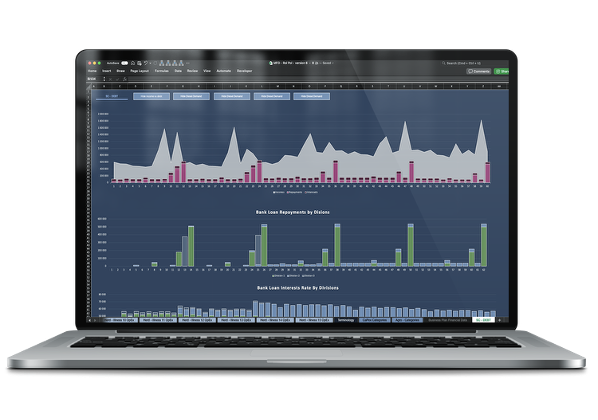
Leasings
The Leasing module covers both operating and finance leases, with the option to select the start date and type of interest.
The module also provides dedicated comparative analyses, enabling the assessment of lease profitability in the context of total cost of ownership, as well as their impact on the company’s long-term financial condition.
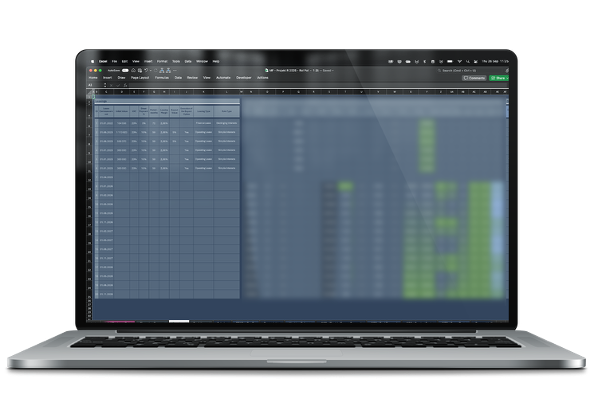
LEASINGS – FUNCTIONALITIES
Types of Leasing: Operating vs. Finance:
- Choice between operating and finance leasing, providing flexibility in managing liabilities and depreciation.
- Ability to analyze the impact of each leasing form on the company’s balance sheet and financial results.
- Automatic categorization of operating leasing as an operating expense and finance leasing as a liability and asset.
Cash Flow and Financial Performance Impact Analysis:
- Calculating the impact of lease payments on the company’s cash flows and financial results.
- Simulation of the impact of leasing costs on EBITDA, net profit, and key financial ratios.
- Assessment of how different forms of leasing affect financial liquidity and profitability.
Selecting the Best Leasing Option:
- Comparison of various leasing offers in terms of total costs, payment terms, and financial benefits.
- Simulations to determine whether operating or finance leasing is more advantageous for a given asset type.
- Analysis of how leased assets affect operational profitability and the potential for their replacement or sale after the contract ends.
Leasing Scenario Simulations:
- Ability to create different leasing repayment scenarios depending on changes in contract terms or external factors like interest rate increases.
- Analysis of variants such as extensions, early contract terminations, and their respective costs and benefits.
- Financial scenarios comparing leasing with other forms of financing (e.g., bank loans).
INVENTURE & WORK IN PROGRESS
The module is designed to provide precise inventory management and enable ongoing reporting to financial institutions such as banks.
Thanks to dynamic data updates, this module delivers up-to-date information on inventory levels, allowing for rapid response to stock changes and facilitating operational and financial decision-making.
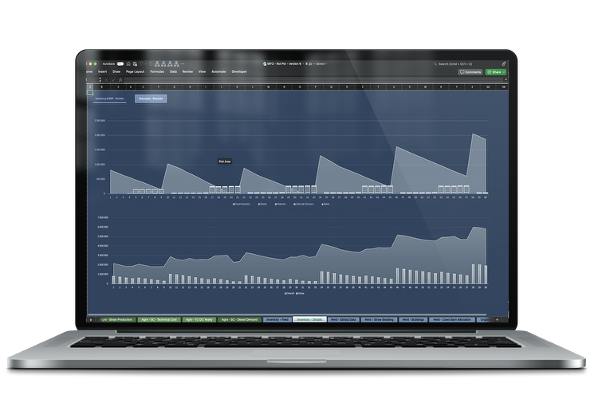
DYNAMIC INVENTURE – FUNCTIONALITIES
Automatic Inventory Updates:
The module continuously monitors and updates inventory information in real time, providing precise data on stock levels.
Bank Reporting:
This functionality enables the generation of inventory reports that comply with banking requirements. As a result, banks can better assess the value of the company’s current assets, which may affect financing terms.
Work in Progress Reporting:
Tracking work in progress (WIP) provides a fuller picture of the value of goods in various stages of processing. This is important for assessing resources already engaged in production but not yet realized as finished products.
Added value in the credit process: Precise data on inventory levels and work in progress can positively influence the company’s credit evaluation, increasing its creditworthiness.
Economic Trends
The Economic Trends module is a comprehensive tool for monitoring key economic indicators that can significantly impact farm costs and profitability. It includes an analysis of quarterly changes in variables such as EUR/PLN exchange rates, raw milk prices in Poland and Germany, WIBOR, and energy, gas, diesel, and gasoline prices.
By continuously tracking the values of these indicators, the user can easily identify trends and anticipate potential market changes.
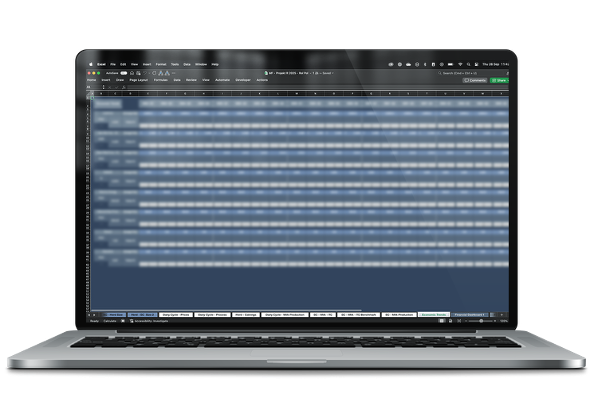
ECONOMIC TRENDS – FUNCTIONALITIES
Proactive Risk Management
The module enables identification of threats stemming from early signals of market changes (e.g., currency rates, energy or commodity prices), allowing for quick protective actions. This helps the company better prepare for potential risks.
Precise Cost Analysis
The module allows monitoring of quarterly shifts in key economic indicators such as WIBOR, energy and fuel prices, and exchange rates. Users can directly link changes in these indicators to specific operating costs, making it easier to optimize budgets and cut unnecessary expenses.
Strategic Budget Planning
By analyzing economic trends, the business can more accurately forecast future operating costs and revenues, ensuring better budget planning and long-term financial management.
Sensitivity Analysis
The module supports sensitivity analysis, helping users understand how changes in economic indicators impact costs and profitability. Users can test various scenarios (e.g., fuel price increases or currency depreciation) and assess their financial impact, enabling informed strategic decisions.
ECONOMIC TRENDS – SAMPLE SCENARIOS
Interest Rate Hike
Situation: The central bank signals a possible rate increase.
Action: User updates interest rates in the module.
Result: The model automatically recalculates financial costs related to loans and leasing and evaluates their impact on future operating costs. Additionally, the user can assess how interest rate changes will affect overall profitability and milk sales margins.
Benefit: Early risk identification allows for planning financial protection or renegotiation of credit terms.
Electricity Price Increase
Situation: Anticipated increase in electricity prices, a significant cost in production.
Action: User updates electricity price forecasts in the module.
Result: The model analyzes how rising energy prices will affect total operating and production costs and profitability. Users can consider investments in renewables or other ways to minimize energy usage.
Benefit: Ability to prepare savings strategies or implement more efficient energy solutions to cushion cost increases.
EUR/PLN Exchange Rate Change
Situation: Economic forecasts indicate a weakening of the złoty against the euro, affecting costs and revenues.
Action: User enters the projected EUR/PLN rate change in the module.
Result: The model calculates the impact of exchange rate changes on import costs and revenues if part of sales is international. It can also assess the impact on overall operating margins.
Benefit: Understanding currency impact on the financial balance enables preparation of hedging strategies or negotiation of contracts.
FINANCIAL STATEMENT
The Financial Statement module is a comprehensive tool for generating complete financial statements for the enterprise, including the balance sheet, income statement, and cash flow statement. It allows for a detailed analysis of the company’s financial position, both historically and in forecasts, supporting liquidity, profitability, and operational efficiency management.
With this module, it is possible to quickly obtain a full picture of the organization’s financial health, making it easier to make strategic decisions based on reliable financial data.
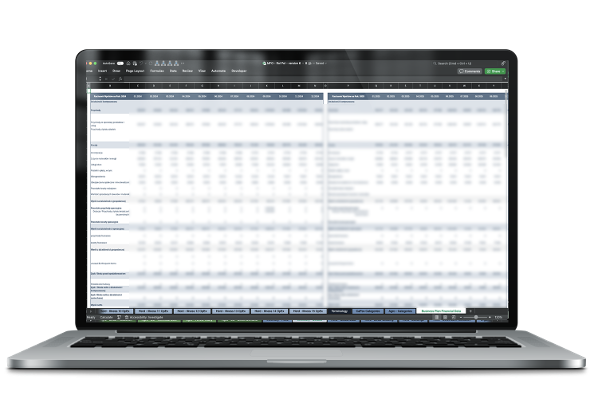
FINANCIAL STATEMENT – BENEFITS
Ongoing financial control:
Provides quick insight into the company’s financial health, enabling informed decisions in response to current market conditions.
Precise forecasting:
The ability to simulate different scenarios helps predict future financial results and better prepare for possible market changes.
Cash flow optimization:
Managing financial liquidity facilitates better expense planning and control over liabilities.
Monitoring financial indicators:
Calculated indicators offer a complete view of profitability and financial stability, supporting effective management and planning for further investments.
Support for strategic decisions:
Dynamic data updates enable managers and investors to adjust financial strategies to current needs and the economic situation.
Ratio Analysis Benchmark
An analytical tool designed to monitor and evaluate the company’s key financial ratios. It enables continuous comparison of results against established reference points (benchmarks), allowing for rapid detection of deviations from assumptions and identification of areas needing improvement.
The module covers, among others, the analysis of liquidity, debt, profitability, and operational efficiency, providing managers with valuable information for making informed strategic and operational decisions.
Thanks to clear data visualization, the module supports financial management and long-term planning within the organization.
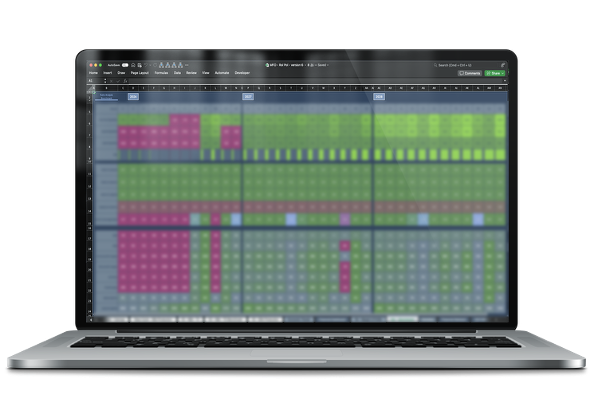
RATIO ANALYSIS BENCHMARK – BENEFITS
Rapid Assessment of Financial Health
By presenting key financial ratios in one place, the module allows for a quick evaluation of the company’s current financial condition. Users can swiftly assess liquidity, debt level, profitability, and operational efficiency without analyzing raw data.
Monitoring Trends and Identifying Anomalies
The module enables long-term ratio analysis (month-to-month, year-to-year), helping to detect trends and changes in financial performance. This aids in spotting anomalies, such as a sudden liquidity drop or debt increase, which may signal problems or a need for corrective action.
Benchmarking and Comparative Analysis
The module offers the ability to compare company results with established benchmarks or industry norms, to assess whether performance meets sector standards. Benchmarking is particularly useful in financial control by helping identify where a company lags behind competitors and needs optimizing.
Support for Risk Management
Monitoring ratios such as debt, liquidity, or interest coverage allows assessment of risks related to indebtedness and the ability to service financial obligations. Regular risk analysis can help minimize potential financial problems and maintain company stability.
Improvement of Operational Efficiency
Ratio analysis of profitability and efficiency (such as gross margin, net margin, ROE, ROA) lets users evaluate which business aspects yield the most profit and which need improvements. These indicators deliver valuable management information that can drive operational enhancements and increase process efficiency.
Foundation for Strategic Planning and Investment Decisions
The module supports strategic planning by providing key financial data, which can underpin decisions about new investments, external financing, or capital management. Profitability and debt ratio analysis enables assessment of planned investment profitability and selection of optimal funding sources.
Enhanced Reporting Transparency and Stakeholder Communication
The financial ratios module allows transparent presentation of results to management, investors, banks, and stakeholders, strengthening trust in the company. Reports in graphical form are clear and easy to interpret, enhancing communication and understanding of the company’s financial situation.
Support in Evaluating Profitability and Achieving Financial Goals
Regular analysis of ratios such as margin, return on equity (ROE), or assets (ROA) helps determine whether the company is meeting its financial goals and profitability targets. This enables ongoing strategic adjustments to maintain profitability and increase owner value.
Quick Identification of Cost Optimization Opportunities
The financial ratios module also aids in analyzing operating costs and their impact on financial results, helping identify and eliminate unnecessary expenses. Operational profitability ratios and cost structure analysis can support expense optimization and improve operating margins.
Adaptation to Changing Market Conditions
Thanks to the module’s dynamic nature, which considers variable financial data, users can adjust decisions to evolving market conditions, such as adjusting debt levels to current loan costs or optimizing capital structure. This allows for agile responses to economic changes and helps maintain financial stability.
DYNAMIC DISCOUNTED CASH FLOW
The DCF-NPV-IRR-BV-ABV valuation module is essential for enterprise value analysis. It provides dynamic valuation using:
- the discounted cash flow (DCF) method,
- book value (BV),
- adjusted net asset value (ABV/NAV).
The module also includes IRR and NPV indicators, enabling profitability assessment for different investment projects.
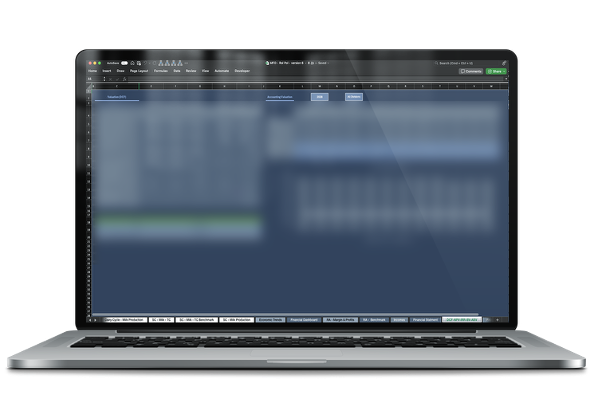
DYNAMIC DISCOUNTED CASH FLOW – BENEFITS FOR SHAREHOLDERS
Forecasting Future Company Value:
The DCF method accounts for future cash flows, making it possible to assess how much the company will be worth in the future. This is especially important for shareholders, as they can anticipate the growth of their investment’s value.
Investment Profitability Analysis:
DCF incorporates the time value of money, enabling an objective evaluation of investment profitability and providing a foundation for long-term growth strategy planning.
Better Control Over Cash Management:
This method allows shareholders to monitor how the company’s operations translate into cash flows. It helps assess whether the company generates enough cash to cover liabilities and whether potential investment projects are properly financed.
Risk Assessment and Financial Ratio Analysis:
DCF takes into account market and operational risk (through the discount rate), enabling shareholders to evaluate more precisely how economic variables impact enterprise value. This allows stakeholders to make decisions based on realistic risk assessments.
DYNAMIC BOOK VALUE
Thanks to dynamic book valuation, which covers both past and future data, shareholders gain a more complete picture of the enterprise’s value over time.
This valuation enables them to track changes in asset values and equity across years, allowing for assessment of the company’s stability and growth potential.
It is also a valuable tool for forecasting future financial results based on current trends and projections, which can be useful when making investment decisions and during negotiations with prospective investors.

DYNAMIC BOOK VALUE – BENEFITS
Transparency and Control:
Dynamic book valuation enables precise tracking of changes in the company’s book value over time, covering both historical and future perspectives. This allows shareholders to monitor how the enterprise uses its resources and capital and better understand how specific business decisions impact the company’s asset value.
Management Flexibility:
The dynamic book value model allows real-time updates of the company’s book value in response to changing market, operational, and financial conditions. In the event of rapid changes—such as interest rates, raw material costs, or capital expenditures—the model can immediately recalculate the company’s value, ensuring quick strategy adjustment.
Enhanced Forecasting and Planning:
By including both historical and forecast data, dynamic book valuation supports the creation of realistic scenarios for company development. Shareholders can analyze future financial results and predict the impact of investment strategies or operational moves on company value, aiding long-term decision making.
Basis for Negotiation:
Having an up-to-date book valuation, dynamically calculated from current data, strengthens the company’s position in negotiations with investors, banks, and business partners. It demonstrates full control over asset and capital values, building trust and increasing credibility.
Risk Management:
Dynamic book valuation lets shareholders promptly identify risk areas in the company’s finances. In case of significant book value fluctuations, shareholders and management can take steps to limit potential losses or adjust their operating strategy.
Capital Optimization:
Analysis based on dynamic book valuation supports efficient capital allocation, helping to identify underused assets or unnecessary investments, which can improve capital structure and the use of equity capital.
Data Reliability:
Thanks to dynamic book valuation, shareholders gain confidence that information on asset values is current and accurate. This valuation incorporates the latest financial and operational changes, eliminating the risk of making decisions based on outdated data.
